Paul van Yperen's Blog, page 399
November 26, 2014
Oleg Strizhenov
Prominent Russian actor Oleg Strizhenov (1929) was both People's Artist of the Soviet Union and a heartthrob, ‘a Russian Gérard Philipe’. He played in more than 31 major films between 1951 and 2000.
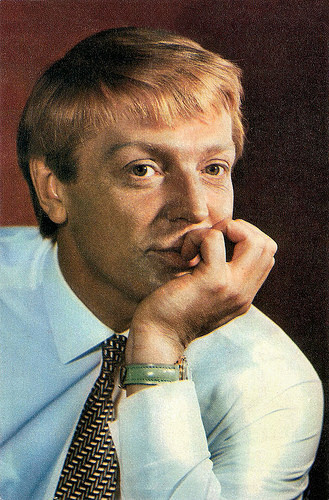
Russian postcard, no. M-40561, 1967. This postcard was printed in an edition of 300.000 cards. Retail price: 8 Kop.
The Queen of Spades
Oleg Aleksandrovich Strizhenov (Олег Александрович Стриженов) was born in Blagoveshchensk in the Far East of the Soviet Union (now Amur Oblast, Russia) in 1929. His brother Gleb and sister Marina would also become actors.
In 1945 Oleg won the Medal ‘For Valiant Labour in the Great Patriotic War 1941-1945’. He completed the B. V. Shukin Higher Theatre School in 1953 and started as an actor in the Russian Theatre of Drama in Tallinn (in Estonia).
From 1954-1955, he acted at the Pushkin Theatre in Leningrad, and in 1957 he was at the Screen Actors Theatre and Studio in Moscow.
In 1951, he had already started his film career with an uncredited bit part in Sportivnaya chest/Sporting Honour (Vladimir Petrov 1951).
In 1955 he played the lead in the drama Ovod/The Gadfly (Aleksandr Fajntsimmer, Iosif Shapiro, 1955), based on the novel The Gadfly by Irish author Ethel Lilian Voynich.
It was followed by the war drama Sorok pervyy/The Forty-First (Grigori Chukhrai, 1956) based on the eponymous novel by Boris Lavrenyev. Set during the Russian Civil War the film tells the story of a tragic romance between a female sniper of the Red Army ( Izolda Izvitskaya ) and an officer of the White Army (Oleg Strizhenov). For his role, Strizhenov got a special prize at the Cannes Film Festival.
In 1957, he starred in the popular Indian-Soviet film Khozhdenie za tri moray/Journey Beyond Three Seas (Khwaja Ahmad Abbas, Vasili Pronin, 1957). It was based on the travelogues of 15th-century Russian traveller Afanasy Nikitin, which is now considered a Russian literary monument. The film was nominated for the Golden Palm at the 1958 Cannes Film Festival.
Another highlight in his film career is the film opera Pikovaya dama/The Queen of Spades (Roman Tikhomirov, 1960), based on the Aleksandr Pushkin short story of the same name. For his performance as Hermann opposite Olga Krasina as Lisa, Strizhenov received Aleksandr Pushkin's Big Gold Medal and the prize of the Russian Musical Fund of Irina Arkhipova.
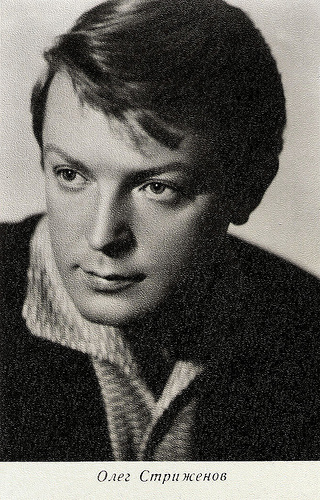
Russian postcard by Izdanije Byuro Propogandy Sovietskogo Kinoiskusstva, no. M 17562 18/II, 1965. This postcard was printed in an edition of 15.000 cards. Retail price: 8 Kop.
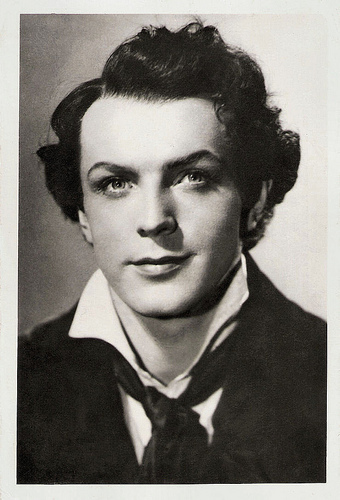
Russian postcard, no. M-19577, 165, 1958. This postcard was printed in an edition of 50.000 cards. Retail price: 70 Kop.
Optimistic Tragedy
In 1963, Oleg Strizhenov appeared in Optimisticheskaya tragediya/Optimistic Tragedy (Samson Samsonov, 1963), which was entered into the 1963 Cannes Film Festival. During Russian Revolution of 1917, the Marine squad, led by anarchist leader Vozhak (Boris Andreyev) starts the revolt. The Central Committee of the Bolshevik Party sends a woman Commissar (Margarita Volodina) to form Red Army battalion from the marines to take part in the Russian Civil War.
The film was shot in Sovscope 70 on black and white film stock. The prints were split into three films for exhibition in Kinopanorama 70 in some theatres. Optimisticheskaya tragediya was the blockbuster in the Soviet cinemas of 1963 with 46 million tickets sold. The film was named Best Film of the Year and Margarita Volodina was named Best Actress of the Year by readers of the Soviet film magazine Sovetsky Ekran.
In 1966 Strizhenov played Pyotr Ilyich Tchaikovsky in the French-Russian Tretya molodost/Nights of Farewell (Jean Dréville, Isaak Menaker, 1966) with Gilles Ségal as Marius Petipa.
From 1966 to 1976 he acted at the Moscow Artists' and Actors' Theatre. In 1970, he was voted best actor of the year for his role as the pilot Egorov in Nepodsuden/Not Under the Jurisdiction (Vladimir Krasnopolskiy, Valeriy Uskov, 1970).
He also appeared in the costume drama Zvezda plenitelnogo schastya/The Captivating Star of Happiness (Vladimir Motyl, 1975). The story is set in the aftermath of the December revolt against Tsar Nicholas I in 1825. The revolt is repressed, and the military officers involved confess one by one. They are sentenced to exile in Siberia and their wives face the decision as to whether or not to follow them. His wife in the film was played by Natalya Bondarchuk.
Other interesting films are the romantic drama Poslednyaya zhertva/The Last Victim (Pyotr Todorovskiy, 1977) with Margarita Volodina, the biographical drama Yunost Petra/The Youth of Peter the Great (Sergei Gerasimov, 1981) and Moy lyubimyy kloun (Yuriy Kushneryov, 1986).
Between 1987 and 2000 he made no films. Oleg Strizhenov was named a People's Artist of the Soviet Union (Народный артист СССР) in 1988.
In 2000 made a come-back with the lead role in Vmesto menya/Instead of me (Vladimir Basov Ml., Olga Basova, 2000). It was to be his final role.
In 2004 he was honoured with the Order of Merit for the Fatherland; 2nd class - For outstanding achievements in the field of cinema and many years of creative activity. During his career he won many more awards and other honours.
Oleg Strizhenov is the father of the Russian actor, writer, producer, and director Aleksandr Strizhenov.
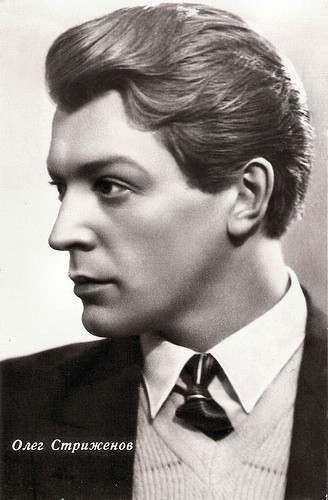
Russian postcard, no. M-55858, 1963. This postcard was printed in an edition of 150.000 cards. Retail price: 8 Kop.
Sources: Voice of Russia, Wikipedia and .

Russian postcard, no. M-40561, 1967. This postcard was printed in an edition of 300.000 cards. Retail price: 8 Kop.
The Queen of Spades
Oleg Aleksandrovich Strizhenov (Олег Александрович Стриженов) was born in Blagoveshchensk in the Far East of the Soviet Union (now Amur Oblast, Russia) in 1929. His brother Gleb and sister Marina would also become actors.
In 1945 Oleg won the Medal ‘For Valiant Labour in the Great Patriotic War 1941-1945’. He completed the B. V. Shukin Higher Theatre School in 1953 and started as an actor in the Russian Theatre of Drama in Tallinn (in Estonia).
From 1954-1955, he acted at the Pushkin Theatre in Leningrad, and in 1957 he was at the Screen Actors Theatre and Studio in Moscow.
In 1951, he had already started his film career with an uncredited bit part in Sportivnaya chest/Sporting Honour (Vladimir Petrov 1951).
In 1955 he played the lead in the drama Ovod/The Gadfly (Aleksandr Fajntsimmer, Iosif Shapiro, 1955), based on the novel The Gadfly by Irish author Ethel Lilian Voynich.
It was followed by the war drama Sorok pervyy/The Forty-First (Grigori Chukhrai, 1956) based on the eponymous novel by Boris Lavrenyev. Set during the Russian Civil War the film tells the story of a tragic romance between a female sniper of the Red Army ( Izolda Izvitskaya ) and an officer of the White Army (Oleg Strizhenov). For his role, Strizhenov got a special prize at the Cannes Film Festival.
In 1957, he starred in the popular Indian-Soviet film Khozhdenie za tri moray/Journey Beyond Three Seas (Khwaja Ahmad Abbas, Vasili Pronin, 1957). It was based on the travelogues of 15th-century Russian traveller Afanasy Nikitin, which is now considered a Russian literary monument. The film was nominated for the Golden Palm at the 1958 Cannes Film Festival.
Another highlight in his film career is the film opera Pikovaya dama/The Queen of Spades (Roman Tikhomirov, 1960), based on the Aleksandr Pushkin short story of the same name. For his performance as Hermann opposite Olga Krasina as Lisa, Strizhenov received Aleksandr Pushkin's Big Gold Medal and the prize of the Russian Musical Fund of Irina Arkhipova.

Russian postcard by Izdanije Byuro Propogandy Sovietskogo Kinoiskusstva, no. M 17562 18/II, 1965. This postcard was printed in an edition of 15.000 cards. Retail price: 8 Kop.

Russian postcard, no. M-19577, 165, 1958. This postcard was printed in an edition of 50.000 cards. Retail price: 70 Kop.
Optimistic Tragedy
In 1963, Oleg Strizhenov appeared in Optimisticheskaya tragediya/Optimistic Tragedy (Samson Samsonov, 1963), which was entered into the 1963 Cannes Film Festival. During Russian Revolution of 1917, the Marine squad, led by anarchist leader Vozhak (Boris Andreyev) starts the revolt. The Central Committee of the Bolshevik Party sends a woman Commissar (Margarita Volodina) to form Red Army battalion from the marines to take part in the Russian Civil War.
The film was shot in Sovscope 70 on black and white film stock. The prints were split into three films for exhibition in Kinopanorama 70 in some theatres. Optimisticheskaya tragediya was the blockbuster in the Soviet cinemas of 1963 with 46 million tickets sold. The film was named Best Film of the Year and Margarita Volodina was named Best Actress of the Year by readers of the Soviet film magazine Sovetsky Ekran.
In 1966 Strizhenov played Pyotr Ilyich Tchaikovsky in the French-Russian Tretya molodost/Nights of Farewell (Jean Dréville, Isaak Menaker, 1966) with Gilles Ségal as Marius Petipa.
From 1966 to 1976 he acted at the Moscow Artists' and Actors' Theatre. In 1970, he was voted best actor of the year for his role as the pilot Egorov in Nepodsuden/Not Under the Jurisdiction (Vladimir Krasnopolskiy, Valeriy Uskov, 1970).
He also appeared in the costume drama Zvezda plenitelnogo schastya/The Captivating Star of Happiness (Vladimir Motyl, 1975). The story is set in the aftermath of the December revolt against Tsar Nicholas I in 1825. The revolt is repressed, and the military officers involved confess one by one. They are sentenced to exile in Siberia and their wives face the decision as to whether or not to follow them. His wife in the film was played by Natalya Bondarchuk.
Other interesting films are the romantic drama Poslednyaya zhertva/The Last Victim (Pyotr Todorovskiy, 1977) with Margarita Volodina, the biographical drama Yunost Petra/The Youth of Peter the Great (Sergei Gerasimov, 1981) and Moy lyubimyy kloun (Yuriy Kushneryov, 1986).
Between 1987 and 2000 he made no films. Oleg Strizhenov was named a People's Artist of the Soviet Union (Народный артист СССР) in 1988.
In 2000 made a come-back with the lead role in Vmesto menya/Instead of me (Vladimir Basov Ml., Olga Basova, 2000). It was to be his final role.
In 2004 he was honoured with the Order of Merit for the Fatherland; 2nd class - For outstanding achievements in the field of cinema and many years of creative activity. During his career he won many more awards and other honours.
Oleg Strizhenov is the father of the Russian actor, writer, producer, and director Aleksandr Strizhenov.

Russian postcard, no. M-55858, 1963. This postcard was printed in an edition of 150.000 cards. Retail price: 8 Kop.
Sources: Voice of Russia, Wikipedia and .
Published on November 26, 2014 23:00
November 25, 2014
Madeleine Ozeray
Franco-Belgian stage and film actress Madeleine Ozeray (1908-1989) appeared in many films between 1932 and 1980.
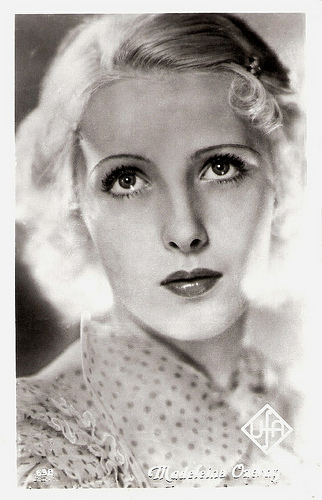
French postcard by Editions Chantal, no. 632. Photo: Ufa.
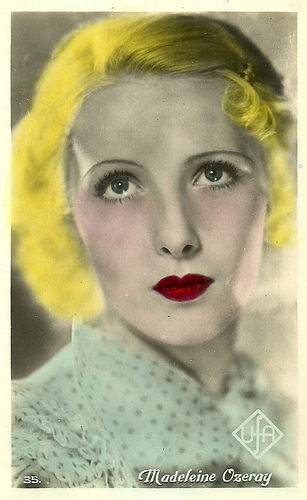
French postcard, no. 35. Photo: Ufa.
Louis Jouvet's Muse
Magdeleine Marie Catherine Elisabeth Ozeray was born in Bouillon in Wallonia in Belgium in 1908 (some sources say 1905). Her parents were Camille Ozeray, a lawyer and Liberal member of the province of Luxembourg, and Marie Deymann.
She studied at the Royal Conservatory of Brussels where she won first prize for comedy. She joined the cast of the Brussels Theatre Marais, directed by Raymond Rouleau, and made her stage debut in April 1931 in The evil of Youth by Ferdinand Bruckner.
Madeleine Ozeray and Raymond Rouleau fell in love. The play was a great success and was presented a few months later in Paris.
Her film debut was a small part in the British French-language comedy La dame de chez Maxim's/The Girl from Maxim's (Alexander Korda, 1932) starring Florelle. It was the French-language version of The Girl from Maxim's (1932) made by London Film Productions. Both films were directed by Korda, and were based on the farce La Dame de chez Maxim (1899) by Georges Feydeau.
She met the famous actor-director Louis Jouvet who offered her the role of Mariette in his film adaptation of the play Knock (1933) by Jules Romains. Soon the two became lovers and Madeleine left Raymond Rouleau.
For the next ten years, she would be Jouvet’s muse and official mistress. She played the female lead of Rosalie in the romantic crime drama Dans les rues/In the streets (Victor Trivas, 1933) opposite Jean-Pierre Aumont .
She also appeared in the fantasy Liliom (Fritz Lang, 1934), based on the Hungarian stage play of the same name by Ferenc Molnár. The film stars Charles Boyer as Liliom, a carousel barker who is fired from his job after defending the chambermaid Julie (Madeleine Ozeray) from the jealousy of Mme. Muscat, the carousel owner who is infatuated with Liliom. Liliom was one of the two first French productions by producer Erich Pommer for Fox-Europa and director Fritz Lang's only French film.
Ozeray also worked on stage and was part of Charles Boyer's stage company. At twenty-seven she joined the theatre company of Louis Jouvet where she played the role of Helen in The Trojan War Will Not Take Place by Jean Giraudoux at the Théâtre de l'Athénée.
In 1939 she appeared opposite Jouvet in the film La Fin du jour/The End of the day (Julien Duvivier, 1938), in the role of young Jeannette. She played her role with a characteristic delicate grace, both fragile and fierce.
In April 1939 Jean Giraudoux's play Ondine opened at the Théâtre de l'Athénée in Paris with Ozeray in the title role. Louis Jouvet was once again the director and her co-star.
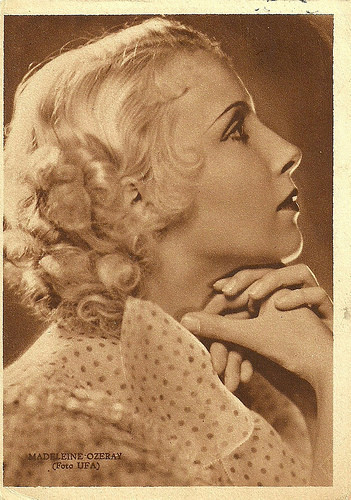
Italian postcard by Ricordi RC, Milano, no. XVIII, 1940. Photo: Ufa.
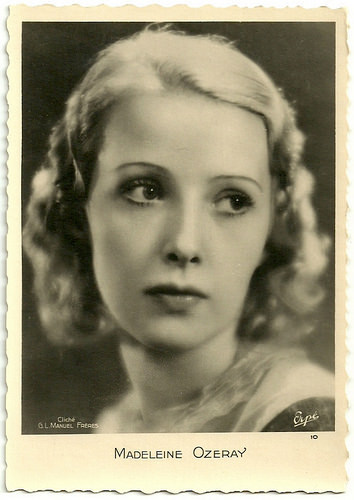
French postcard by Erpé, no. 10. Photo: G.L. Manuel Frères.
Philippe Noiret’s mother
During the war Madeleine Ozeray refused to work under the Nazis who occupied France and she joined Louis Jouvet on a Latin-American tour, where they performed in plays by Molière, Jean Giraudoux, Alfred de Musset and Jules Romains.
In 1943 in Chile, she left Jouvet for the conductor Cesar Mendoza. After the war her film career halted.
In the 1970s, she returned to the screen. First she appeared on television in episodes of such series as Le tribunal de l'impossible/The court of the impossible (Pierre Badel, 1970) and Tang (André Michel, 1971).
Later followed roles in films like the crime drama Les Anges/The Angels (Jean Desvilles, 1973) and the drama La race des 'seigneurs'/Creezy (Pierre Granier-Deferre, 1974) starring Alain Delon .
She played Philippe Noiret’s mother in the war drama Le vieux fusil/The Old Gun (Robert Enrico, 1975) with Romy Schneider .
Another interesting film was Chère inconnue/I Sent a Letter to My Love (Moshe Mizrahi, 1980), starring Simone Signoret and Jean Rochefort . Her final screen appearance was in the series Les dossiers éclatés/The broken records (1980).
In 1989, Madeleine Ozeray died in Paris at the age of 80 after a long battle with Alzheimer’s disease (some sources say cancer). She is buried in the cemetery of her hometown of Bouillon. She was the godmother of theatre actor, dancer and singer Frédéric Norbert.
In 2008, in celebration of the centenary of her birth, Belgian journalist Dominique Zachary devoted an entire book, now the standard reference work, tracing the life and career of this celebrated actress.
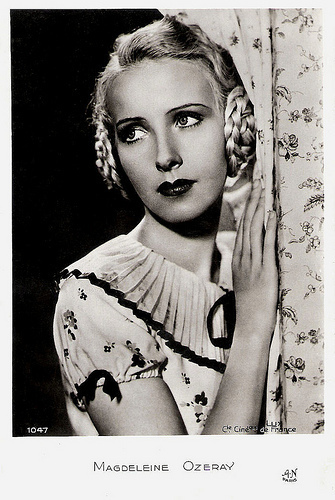
French postcard by A.N., Paris, no. 1047. Photo: Lux / Cie. Ciné de France.
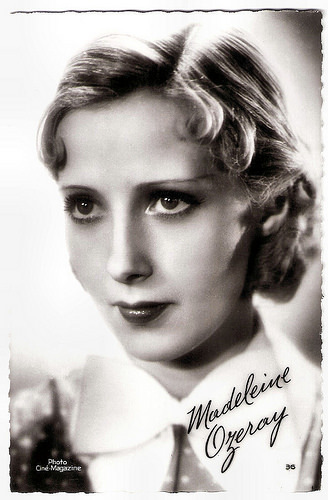
French postcard by Editions et Publications Cinematographiques, no. 36. Photo: Ciné-Magazine.
Sources: Pascal Donald (CineArtistes – French), Cinememorial (French), Wikipedia (French and English) and .

French postcard by Editions Chantal, no. 632. Photo: Ufa.

French postcard, no. 35. Photo: Ufa.
Louis Jouvet's Muse
Magdeleine Marie Catherine Elisabeth Ozeray was born in Bouillon in Wallonia in Belgium in 1908 (some sources say 1905). Her parents were Camille Ozeray, a lawyer and Liberal member of the province of Luxembourg, and Marie Deymann.
She studied at the Royal Conservatory of Brussels where she won first prize for comedy. She joined the cast of the Brussels Theatre Marais, directed by Raymond Rouleau, and made her stage debut in April 1931 in The evil of Youth by Ferdinand Bruckner.
Madeleine Ozeray and Raymond Rouleau fell in love. The play was a great success and was presented a few months later in Paris.
Her film debut was a small part in the British French-language comedy La dame de chez Maxim's/The Girl from Maxim's (Alexander Korda, 1932) starring Florelle. It was the French-language version of The Girl from Maxim's (1932) made by London Film Productions. Both films were directed by Korda, and were based on the farce La Dame de chez Maxim (1899) by Georges Feydeau.
She met the famous actor-director Louis Jouvet who offered her the role of Mariette in his film adaptation of the play Knock (1933) by Jules Romains. Soon the two became lovers and Madeleine left Raymond Rouleau.
For the next ten years, she would be Jouvet’s muse and official mistress. She played the female lead of Rosalie in the romantic crime drama Dans les rues/In the streets (Victor Trivas, 1933) opposite Jean-Pierre Aumont .
She also appeared in the fantasy Liliom (Fritz Lang, 1934), based on the Hungarian stage play of the same name by Ferenc Molnár. The film stars Charles Boyer as Liliom, a carousel barker who is fired from his job after defending the chambermaid Julie (Madeleine Ozeray) from the jealousy of Mme. Muscat, the carousel owner who is infatuated with Liliom. Liliom was one of the two first French productions by producer Erich Pommer for Fox-Europa and director Fritz Lang's only French film.
Ozeray also worked on stage and was part of Charles Boyer's stage company. At twenty-seven she joined the theatre company of Louis Jouvet where she played the role of Helen in The Trojan War Will Not Take Place by Jean Giraudoux at the Théâtre de l'Athénée.
In 1939 she appeared opposite Jouvet in the film La Fin du jour/The End of the day (Julien Duvivier, 1938), in the role of young Jeannette. She played her role with a characteristic delicate grace, both fragile and fierce.
In April 1939 Jean Giraudoux's play Ondine opened at the Théâtre de l'Athénée in Paris with Ozeray in the title role. Louis Jouvet was once again the director and her co-star.

Italian postcard by Ricordi RC, Milano, no. XVIII, 1940. Photo: Ufa.

French postcard by Erpé, no. 10. Photo: G.L. Manuel Frères.
Philippe Noiret’s mother
During the war Madeleine Ozeray refused to work under the Nazis who occupied France and she joined Louis Jouvet on a Latin-American tour, where they performed in plays by Molière, Jean Giraudoux, Alfred de Musset and Jules Romains.
In 1943 in Chile, she left Jouvet for the conductor Cesar Mendoza. After the war her film career halted.
In the 1970s, she returned to the screen. First she appeared on television in episodes of such series as Le tribunal de l'impossible/The court of the impossible (Pierre Badel, 1970) and Tang (André Michel, 1971).
Later followed roles in films like the crime drama Les Anges/The Angels (Jean Desvilles, 1973) and the drama La race des 'seigneurs'/Creezy (Pierre Granier-Deferre, 1974) starring Alain Delon .
She played Philippe Noiret’s mother in the war drama Le vieux fusil/The Old Gun (Robert Enrico, 1975) with Romy Schneider .
Another interesting film was Chère inconnue/I Sent a Letter to My Love (Moshe Mizrahi, 1980), starring Simone Signoret and Jean Rochefort . Her final screen appearance was in the series Les dossiers éclatés/The broken records (1980).
In 1989, Madeleine Ozeray died in Paris at the age of 80 after a long battle with Alzheimer’s disease (some sources say cancer). She is buried in the cemetery of her hometown of Bouillon. She was the godmother of theatre actor, dancer and singer Frédéric Norbert.
In 2008, in celebration of the centenary of her birth, Belgian journalist Dominique Zachary devoted an entire book, now the standard reference work, tracing the life and career of this celebrated actress.

French postcard by A.N., Paris, no. 1047. Photo: Lux / Cie. Ciné de France.

French postcard by Editions et Publications Cinematographiques, no. 36. Photo: Ciné-Magazine.
Sources: Pascal Donald (CineArtistes – French), Cinememorial (French), Wikipedia (French and English) and .
Published on November 25, 2014 23:00
November 24, 2014
Jack Hulbert
British actor Jack Hulbert (1892-1978) was a popular comedian of the 1930s with a trademark chiselled chin. In his musicals he often appeared with his wife Cicely Courtneidge.
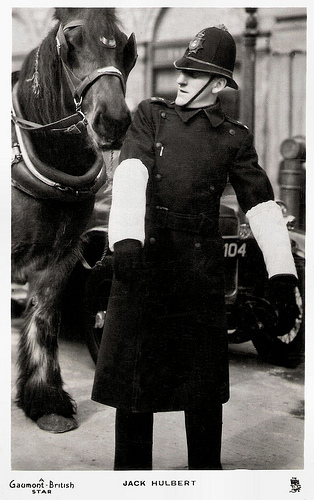
British postcard by Raphael Tuck & Sons 'Real Photograph', no. 15. Photo: Gaumont-British.
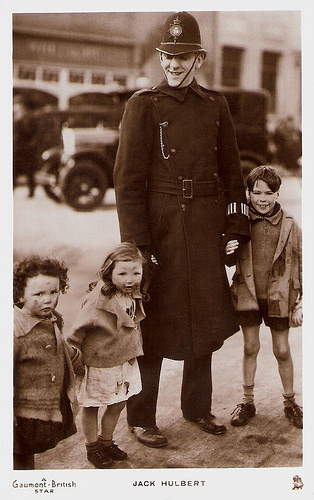
British postcard by Raphael Tuck & Sons 'Real Photograph', no. 16-8. Photo: Gaumont-British.
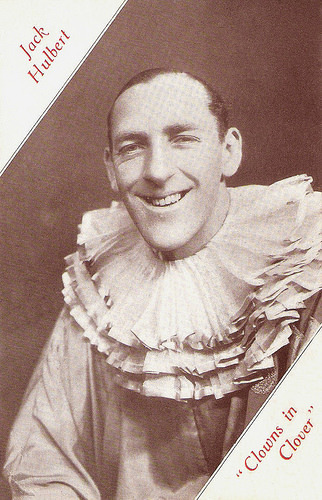
British postcard by Henry Good & Son. Promotion card for the stage musical Clowns in Clover (1927) in the Adelphi Theatre in London.
Famous Alumni of the Comedy Club
John Norman ‘Jack’ Hulbert was born in Ely, Cambridgeshire, in 1892. He was the elder and more successful brother of Claude Hulbert .
Jack was educated at Cambridge and appeared in many shows and revues, mainly with the Cambridge Footlights. He was one of the earliest famous alumni of the comedy club.
After Cambridge, he earned recognition and fame performing in musicals and light comedies. He made his film debut in Elstree Calling (André Charlot, Jack Hulbert, Paul Murray, ánd Alfred Hitchcock (who directed some sketches), 1930); appearing opposite his wife and frequent stage and screen co-star Cicely Courtneidge whom he had married in 1916.
His career went through a successful period during the 1930s when he appeared in several films including The Ghost Train (Walter Forde, 1931) with Cicely Courtneidge , Love on Wheels (Victor Saville, 1932) with Edmund Gwenn, and Bulldog Jack (Walter Forde, 1935), a tongue-in-cheek homage to the popular Bulldog Drummond films in which Jack was supported by his brother Claude and King Kong’s mate Fay Wray.
He also wrote and directed some films such as Falling for You (Jack Hulbert, Robert Stevenson, 1933) with Cicely Courtneidge and Tamara Desni , the daughter of silent star Xenia Desni .
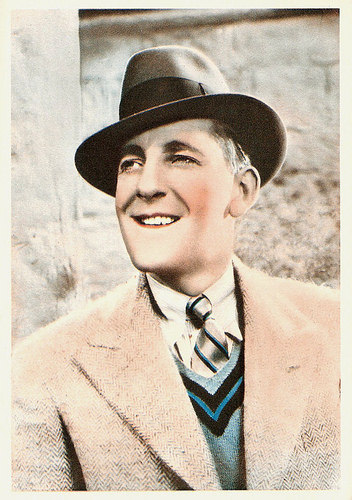
British collectors card by De Reszke Cigarettes, no. 30. Photo: Gaumont-British.
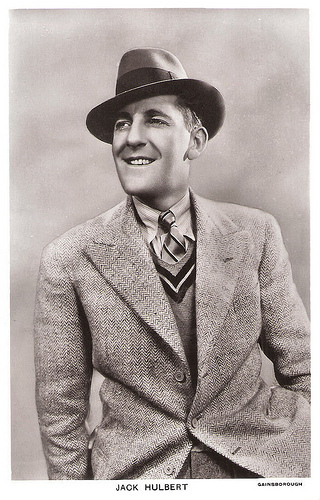
British postcard in the Picturegoer Series, London, no. 782. Photo: Gainsborough.
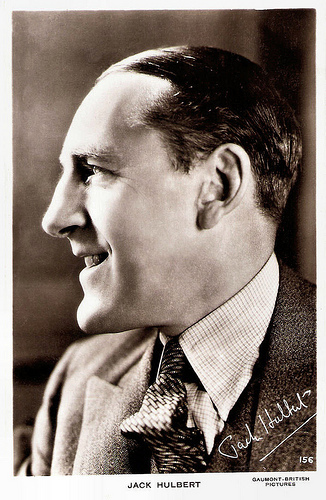
British postcard by Real Photograph, no. 156. Photo: Gaumont-British Pictures.
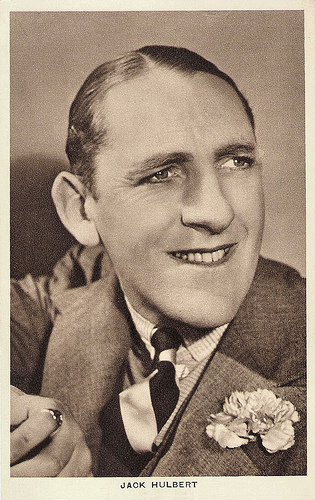
British card.
The Little Woman's Always Right
Jack Hulbert's popularity waned as the 1930s came to an end. Some of his later films were Jack of All Trades (Jack Hulbert, Robert Stevenson, 1936) and Paradise for Two (Thornton Freeland, 1938) with Patricia Ellis and Googie Withers.
During the 1940s, he was a Commandant in the Metropolitan Special Constabulary, stationed at Vine Street police station in London's West End.
After the war he and his wife continued to entertain chiefly on stage. Among his later films were Into the Blue (Herbert Wilcox, 1950) starring Michael Wilding, and the crime film Miss Tulip Stays the Night (Leslie Arliss, 1955) starring Diana Dors .
On TV he was seen in episodes of Kraft Mystery Theater (1961), Compact (1964), Theatre 625 (1968), and Father Dear Father (1972).
In 1962 he, along with his wife, Cicely Courtneidge , plus Vic Oliver , appeared in the BBC radio sitcom Discord in Three Flats. His final film was The Cherry Picker (Peter Curran, 1974) starring Lulu.
In 1975, Hulbert's autobiography, The Little Woman's Always Right, was published. His marriage to Cicely Courtneidge lasted for 62 years until his death. Their relationship is mentioned in the British television series Dad's Army in the episode Ring Dem Bells when Hulbert pulls out of shooting a Home Guard training film to spend time with his wife.
Jack Hulbert died, aged 85, at his home in Westminster, London, in 1978.
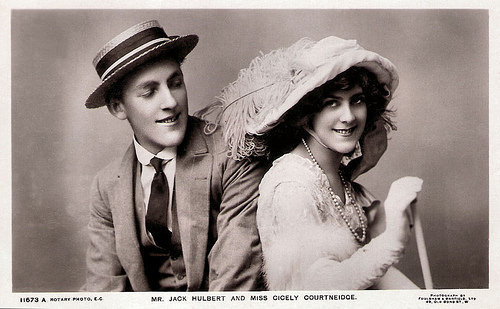
With Cicely Courtneidge. British postcard in the Rotary Photographic Series, no. 11673 A. Photo: Foulsham & Banfield.
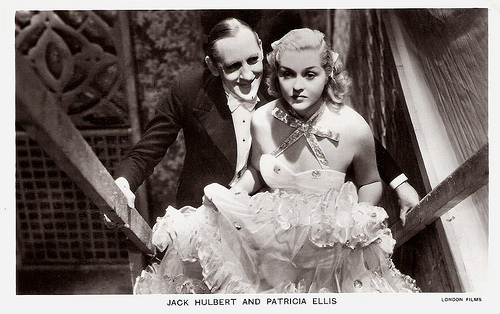
British postcard in the Film Partners Series, London, no. P 241. Photo: London Films. Publicity still for Paradise for Two/Gaiety Girls (Thornton Freeland, 1937) with Jack Hulbert and Patricia Ellis.
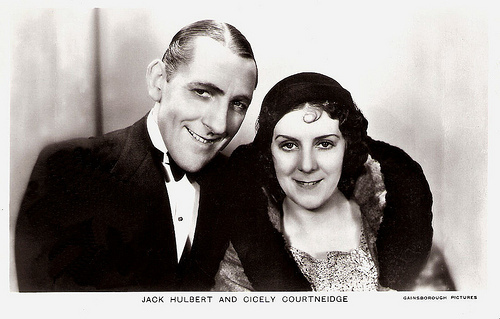
With Cicely Courtneidge. British postcard in the Film Partners Series, no. P 42. Photo: Gainsborough Pictures.
Sources: Wikipedia, and .

British postcard by Raphael Tuck & Sons 'Real Photograph', no. 15. Photo: Gaumont-British.

British postcard by Raphael Tuck & Sons 'Real Photograph', no. 16-8. Photo: Gaumont-British.

British postcard by Henry Good & Son. Promotion card for the stage musical Clowns in Clover (1927) in the Adelphi Theatre in London.
Famous Alumni of the Comedy Club
John Norman ‘Jack’ Hulbert was born in Ely, Cambridgeshire, in 1892. He was the elder and more successful brother of Claude Hulbert .
Jack was educated at Cambridge and appeared in many shows and revues, mainly with the Cambridge Footlights. He was one of the earliest famous alumni of the comedy club.
After Cambridge, he earned recognition and fame performing in musicals and light comedies. He made his film debut in Elstree Calling (André Charlot, Jack Hulbert, Paul Murray, ánd Alfred Hitchcock (who directed some sketches), 1930); appearing opposite his wife and frequent stage and screen co-star Cicely Courtneidge whom he had married in 1916.
His career went through a successful period during the 1930s when he appeared in several films including The Ghost Train (Walter Forde, 1931) with Cicely Courtneidge , Love on Wheels (Victor Saville, 1932) with Edmund Gwenn, and Bulldog Jack (Walter Forde, 1935), a tongue-in-cheek homage to the popular Bulldog Drummond films in which Jack was supported by his brother Claude and King Kong’s mate Fay Wray.
He also wrote and directed some films such as Falling for You (Jack Hulbert, Robert Stevenson, 1933) with Cicely Courtneidge and Tamara Desni , the daughter of silent star Xenia Desni .

British collectors card by De Reszke Cigarettes, no. 30. Photo: Gaumont-British.

British postcard in the Picturegoer Series, London, no. 782. Photo: Gainsborough.

British postcard by Real Photograph, no. 156. Photo: Gaumont-British Pictures.

British card.
The Little Woman's Always Right
Jack Hulbert's popularity waned as the 1930s came to an end. Some of his later films were Jack of All Trades (Jack Hulbert, Robert Stevenson, 1936) and Paradise for Two (Thornton Freeland, 1938) with Patricia Ellis and Googie Withers.
During the 1940s, he was a Commandant in the Metropolitan Special Constabulary, stationed at Vine Street police station in London's West End.
After the war he and his wife continued to entertain chiefly on stage. Among his later films were Into the Blue (Herbert Wilcox, 1950) starring Michael Wilding, and the crime film Miss Tulip Stays the Night (Leslie Arliss, 1955) starring Diana Dors .
On TV he was seen in episodes of Kraft Mystery Theater (1961), Compact (1964), Theatre 625 (1968), and Father Dear Father (1972).
In 1962 he, along with his wife, Cicely Courtneidge , plus Vic Oliver , appeared in the BBC radio sitcom Discord in Three Flats. His final film was The Cherry Picker (Peter Curran, 1974) starring Lulu.
In 1975, Hulbert's autobiography, The Little Woman's Always Right, was published. His marriage to Cicely Courtneidge lasted for 62 years until his death. Their relationship is mentioned in the British television series Dad's Army in the episode Ring Dem Bells when Hulbert pulls out of shooting a Home Guard training film to spend time with his wife.
Jack Hulbert died, aged 85, at his home in Westminster, London, in 1978.

With Cicely Courtneidge. British postcard in the Rotary Photographic Series, no. 11673 A. Photo: Foulsham & Banfield.

British postcard in the Film Partners Series, London, no. P 241. Photo: London Films. Publicity still for Paradise for Two/Gaiety Girls (Thornton Freeland, 1937) with Jack Hulbert and Patricia Ellis.

With Cicely Courtneidge. British postcard in the Film Partners Series, no. P 42. Photo: Gainsborough Pictures.
Sources: Wikipedia, and .
Published on November 24, 2014 23:00
November 23, 2014
Vladimir Gajdarov
Ukrainian actor Vladimir Gajdarov (1893-1976) (on Germany known as Wladimir Gaidarow) began his film career in Russia before the October Revolution. Later he became a popular star of the German and French silent cinema. Sound film made his return to his home country, but in the Soviet Union he had a hard time getting work.
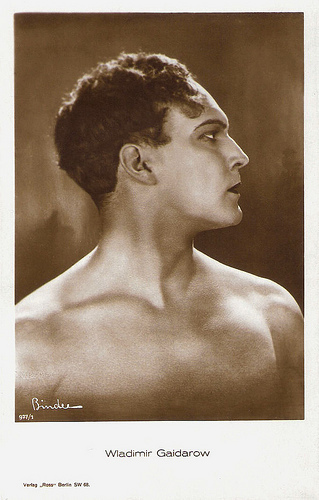
German postcard by Ross Verlag, no. 977/1, 1925-1926. Photo: Alex Binder, Berlin.
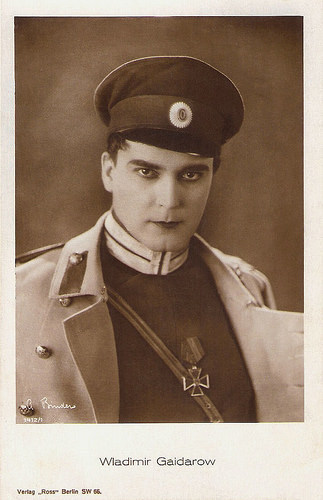
German postcard by Ross Verlag, no. 1412/1, 1927-1928. Photo: Alex Binder, Berlin.
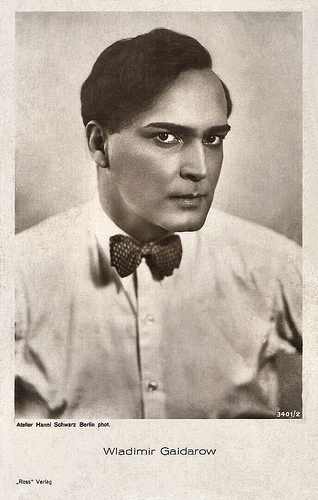
German postcard by Ross Verlag, no. 3401/2, 1928-1929. Photo: Atelier Hanni Schwarz, Berlin.
Stanislavski
Vladimir Georgiyevich Gajdarov was born in Poltava, Russian Empire (now Ukraine), in 1893. He supposedly was the son of a noble family.
He studied history, philosophy and German language before he became a pupil of the famous stage director Konstantin Stanislavski. Soon he became a very popular actor on the Russian stage.
He began his film career in Russia before the October Revolution. His first appearance was opposite his wife-to-be, the famous Stanislavki actress Olga Gzovskaya, in Yeyo zhertva/Her Sacrifice (Cheslav Sabinsky, 1917) based on a play by Henrik Ibsen.
Next he played with Ivan Mozzhukhin in Ne nado krovi/Blood Need Not Be Spilled (Yakov Protazanov, Alexandre Volkoff, 1917). The two actors were also featured in Otyets Sergei/Father Sergei (Yakov Protazanov, Alexandre Volkoff, 1917-1918), based on a Leo Tolstoy story. This popular film tells the tale of an officer who becomes a monk after hearing of his fiancée's affair with the Tsar.
Another film was Iola (1920) by animation filmmaker Wladyslaw Starewicz. In 1920 Gajdarov and Olga Gzovskaya left Russia. They eventually arrived in Turkey, and in Constantinople he directed two films to raise money to aid the many stranded Russian refugees who had fled the Bolsheviks.
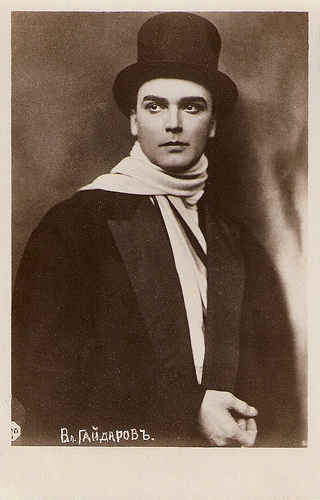
Latvian (?) postcard by KLTD.
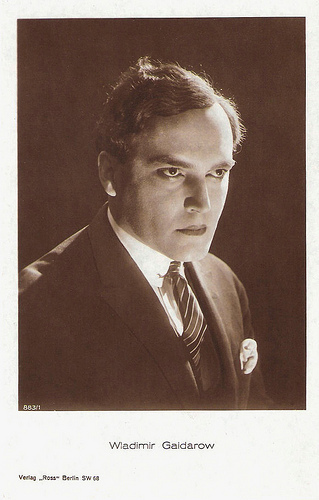
German postcard by Ross Verlag, no. 883/1, 1925-1926.
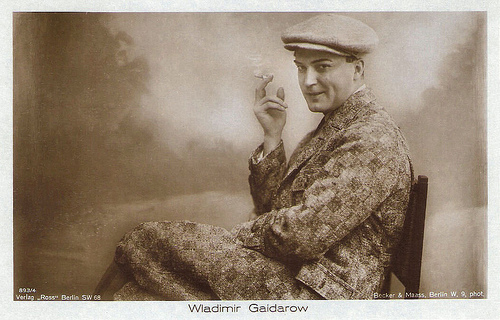
German postcard by Ross Verlag, no. 893/4, 1925-1926. Photo: Becker & Maass, Berlin.
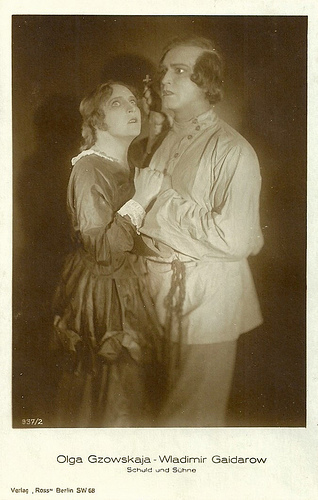
German postcard by Ross Verlag, no. 937/2, 1925-1926. Vladimir Gajdarov and Olga Gzovskaya in Schuld und Sühne, an adaptation of Dostojevski's Crime and Punishment (Raskolnikov). Unclear which film this is, as a 1922/1923 German version, called Raskolnikow (directed by Robert Wiene), starred Grigori Chmara and not Gajdarov.
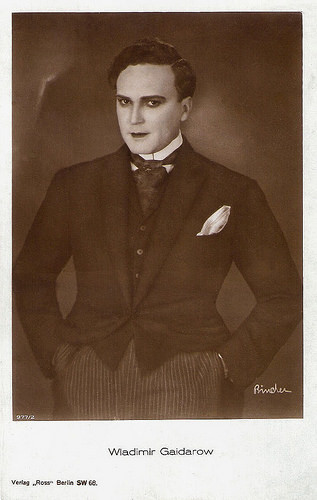
German postcard by Ross Verlag, no. 977/2, 1925-1926. Photo: Alex Binder, Berlin.
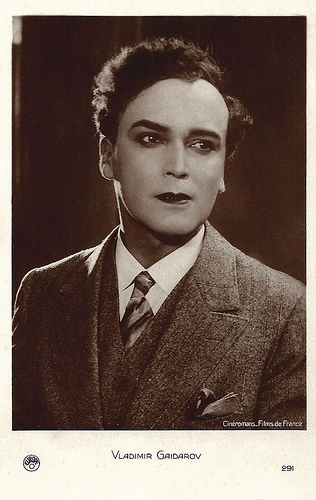
French postcard by Europe no. 291. Photo: Cinéromans Films de France.
Haunted, pale face
In the following years Vladimir Gajdarov worked in various European countries. Especially in Germany he found rewarding roles in films.
With his haunted, pale face he acted in Der brennende Acker/The Burning Earth (F.W. Murnau, 1922) opposite Lya de Putti , and in Die Gezeichneten/Love One Another (Carl Theodor Dreyer, 1922).
Other popular German films were the Alexandre Dumas père adaptation Der Mann mit der eisernen Maske/The Man in the Iron Mask (Max Glass, 1923) starring Albert Bassermann , the serial Tragödie der Liebe/The Tragedy of Love (Joe May, 1923) with Marlene Dietrich , and in Manon Lescaut (Arthur Robison, 1926), again opposite Lya de Putti .
In France he appeared as Vladimir Gaidaroff in Le roman d'un jeune homme pauvre/The Novel of a Poor Young Man (Gaston Ravel, 1926) with Maly Delschaft , and in La Madone des sleepings/Madonna of the Sleeping Cars (Marco de Gastyne, Maurice Gleize, 1927).
He starred as an exotic lady-killer in Die Weisse Sklavin/The White Slave (Augusto Genina, 1927) opposite Liane Haid , and in Frauenraub in Marokko (Gennaro Righelli, 1928) with Dolly Davis .
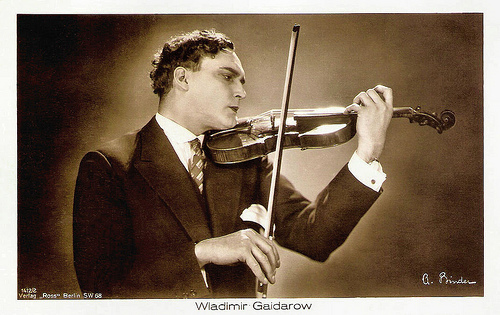
German postcard by Ross Verlag, Berlin, no. 1412/2, 1927-1928. Photo: Alex Binder.
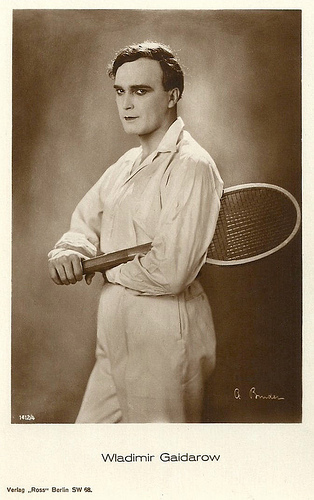
German postcard by Ross Verlag, Berlin, no. 1412/4, 1927-1928. Photo: Alex Binder.
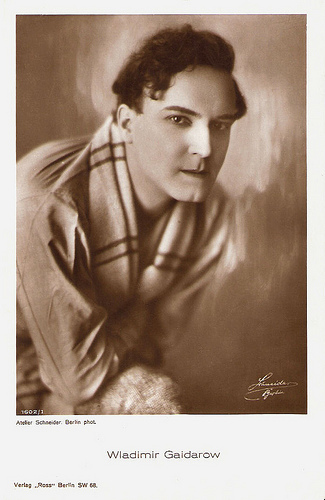
German postcard. Ross Verlag, no. 1602/1, 1927-1928. Photo: Atelier Schneider, Berlin.
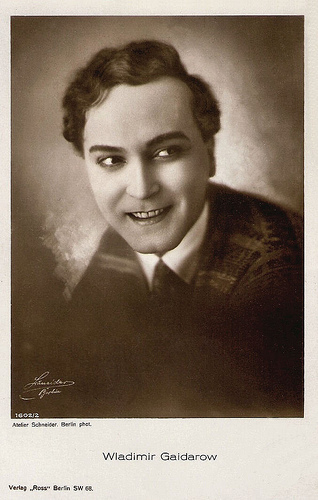
German postcard by Ross Verlag, no. 1602/2, 1927-1928. Photo: Atelier Schneider, Berlin.
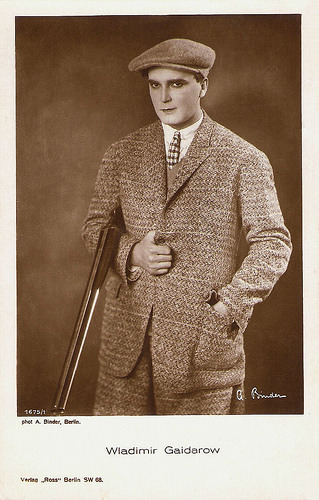
German postcard by Ross Verlag, no. 1673/1, 1927-1928. Photo: Alex Binder, Berlin.
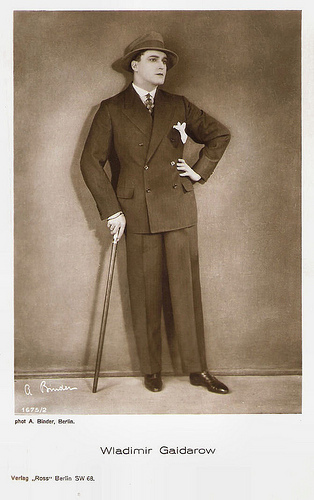
German postcard by Ross Verlag, no. 1675/2, 1927-1928. Photo: Alex Binder, Berlin.
Siberia
When the sound film arrived Vladimir Gajdarov's possibilities on the international film scene were seriously reduced. In 1930 he took on the position of film director and producer and made Kire lained/Wells of Passion (1930) with Ita Rina , but soon he had to return to acting again.
He appeared in a few German productions like Nachtkolonne/Night Convoy (James Bauer, 1931), and Luise, Königin von Preussen/Luise, Queen of Prussia (Carl Froelich, 1931), starring Henny Porten .
In 1932 he and Olga Gzovskaya returned to the Soviet Union. As former émigrés, they were unable to find employment until 1937.
During the Stalinist repression, with hundreds of people arrested every day, Gzovskaya wrote to Stanislavski twice, begging for his help. Stanislavski responded with a letter, which helped them both to find professional work in theatres in Leningrad.
Later Gajdarov appeared in the propaganda film Stalingradskaya bitva/The Battle of Stalingrad (Vladimir Petrov, 1949-1950), Geroite na Shipka/Heroes of Shipka (Sergei Vasilyev, 1954), and the Norwegian-Russian coproduction Bare et liv/The History of Fridtjof Nansen (Sergei Mikalyen, 1968).
Vladimir Gajdarov published his memoirs in 1966. He died in Poltava, Siberia in 1976.
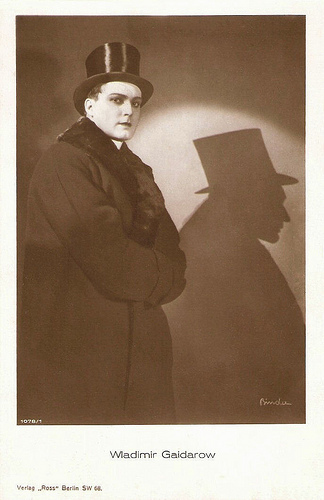
German postcard by Ross, Berlin, no. 1978/1, 1927-1928. Photo: Alex Binder.
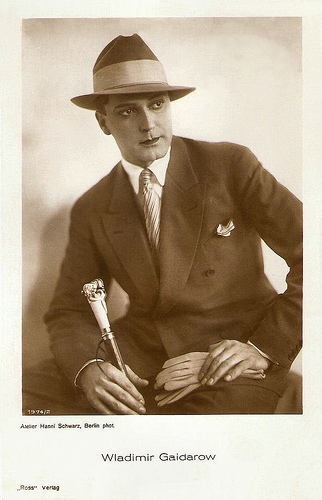
German postcard by Ross, Berlin, no. 1974/2, 1927-1928. Photo: Atelier Hanni Schwarz, Berlin.
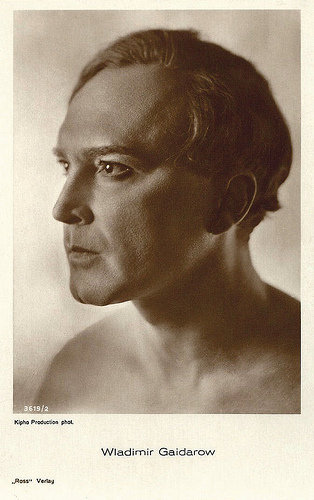
German postcard by Ross Verlag no. 3619/2, 1928-1929. Photo: Kipho Production.
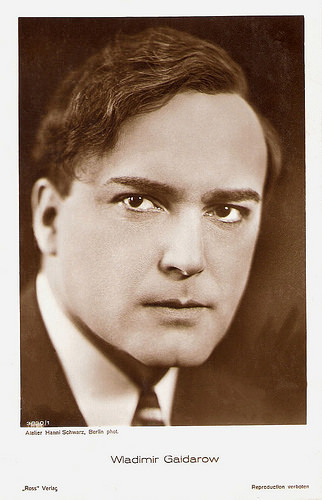
German postcard by Ross Verlag, no. 3830/1, 1928-1929. Photo: Atelier Hanni Schwarz, Berlin.
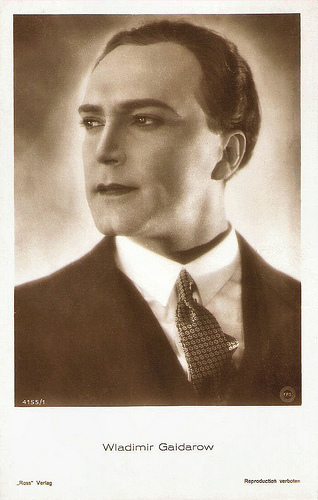
German postcard by Ross Verlag, Berlin, no. 4155/1, 1929-1930. Photo: FPS.
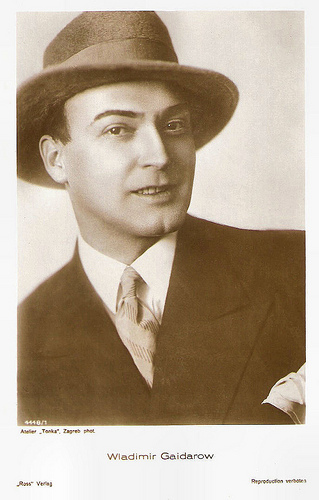
German postcard by Ross Verlag, Berlin, no. 4448/1, 1929-1930. Photo: Atelier Tonka, Zagreb.
Sources: Thomas Staedeli (Cyranos), Silents are Golden, The Silent Cinema Reader, Wikipedia and .

German postcard by Ross Verlag, no. 977/1, 1925-1926. Photo: Alex Binder, Berlin.

German postcard by Ross Verlag, no. 1412/1, 1927-1928. Photo: Alex Binder, Berlin.

German postcard by Ross Verlag, no. 3401/2, 1928-1929. Photo: Atelier Hanni Schwarz, Berlin.
Stanislavski
Vladimir Georgiyevich Gajdarov was born in Poltava, Russian Empire (now Ukraine), in 1893. He supposedly was the son of a noble family.
He studied history, philosophy and German language before he became a pupil of the famous stage director Konstantin Stanislavski. Soon he became a very popular actor on the Russian stage.
He began his film career in Russia before the October Revolution. His first appearance was opposite his wife-to-be, the famous Stanislavki actress Olga Gzovskaya, in Yeyo zhertva/Her Sacrifice (Cheslav Sabinsky, 1917) based on a play by Henrik Ibsen.
Next he played with Ivan Mozzhukhin in Ne nado krovi/Blood Need Not Be Spilled (Yakov Protazanov, Alexandre Volkoff, 1917). The two actors were also featured in Otyets Sergei/Father Sergei (Yakov Protazanov, Alexandre Volkoff, 1917-1918), based on a Leo Tolstoy story. This popular film tells the tale of an officer who becomes a monk after hearing of his fiancée's affair with the Tsar.
Another film was Iola (1920) by animation filmmaker Wladyslaw Starewicz. In 1920 Gajdarov and Olga Gzovskaya left Russia. They eventually arrived in Turkey, and in Constantinople he directed two films to raise money to aid the many stranded Russian refugees who had fled the Bolsheviks.

Latvian (?) postcard by KLTD.

German postcard by Ross Verlag, no. 883/1, 1925-1926.

German postcard by Ross Verlag, no. 893/4, 1925-1926. Photo: Becker & Maass, Berlin.

German postcard by Ross Verlag, no. 937/2, 1925-1926. Vladimir Gajdarov and Olga Gzovskaya in Schuld und Sühne, an adaptation of Dostojevski's Crime and Punishment (Raskolnikov). Unclear which film this is, as a 1922/1923 German version, called Raskolnikow (directed by Robert Wiene), starred Grigori Chmara and not Gajdarov.

German postcard by Ross Verlag, no. 977/2, 1925-1926. Photo: Alex Binder, Berlin.

French postcard by Europe no. 291. Photo: Cinéromans Films de France.
Haunted, pale face
In the following years Vladimir Gajdarov worked in various European countries. Especially in Germany he found rewarding roles in films.
With his haunted, pale face he acted in Der brennende Acker/The Burning Earth (F.W. Murnau, 1922) opposite Lya de Putti , and in Die Gezeichneten/Love One Another (Carl Theodor Dreyer, 1922).
Other popular German films were the Alexandre Dumas père adaptation Der Mann mit der eisernen Maske/The Man in the Iron Mask (Max Glass, 1923) starring Albert Bassermann , the serial Tragödie der Liebe/The Tragedy of Love (Joe May, 1923) with Marlene Dietrich , and in Manon Lescaut (Arthur Robison, 1926), again opposite Lya de Putti .
In France he appeared as Vladimir Gaidaroff in Le roman d'un jeune homme pauvre/The Novel of a Poor Young Man (Gaston Ravel, 1926) with Maly Delschaft , and in La Madone des sleepings/Madonna of the Sleeping Cars (Marco de Gastyne, Maurice Gleize, 1927).
He starred as an exotic lady-killer in Die Weisse Sklavin/The White Slave (Augusto Genina, 1927) opposite Liane Haid , and in Frauenraub in Marokko (Gennaro Righelli, 1928) with Dolly Davis .

German postcard by Ross Verlag, Berlin, no. 1412/2, 1927-1928. Photo: Alex Binder.

German postcard by Ross Verlag, Berlin, no. 1412/4, 1927-1928. Photo: Alex Binder.

German postcard. Ross Verlag, no. 1602/1, 1927-1928. Photo: Atelier Schneider, Berlin.

German postcard by Ross Verlag, no. 1602/2, 1927-1928. Photo: Atelier Schneider, Berlin.

German postcard by Ross Verlag, no. 1673/1, 1927-1928. Photo: Alex Binder, Berlin.

German postcard by Ross Verlag, no. 1675/2, 1927-1928. Photo: Alex Binder, Berlin.
Siberia
When the sound film arrived Vladimir Gajdarov's possibilities on the international film scene were seriously reduced. In 1930 he took on the position of film director and producer and made Kire lained/Wells of Passion (1930) with Ita Rina , but soon he had to return to acting again.
He appeared in a few German productions like Nachtkolonne/Night Convoy (James Bauer, 1931), and Luise, Königin von Preussen/Luise, Queen of Prussia (Carl Froelich, 1931), starring Henny Porten .
In 1932 he and Olga Gzovskaya returned to the Soviet Union. As former émigrés, they were unable to find employment until 1937.
During the Stalinist repression, with hundreds of people arrested every day, Gzovskaya wrote to Stanislavski twice, begging for his help. Stanislavski responded with a letter, which helped them both to find professional work in theatres in Leningrad.
Later Gajdarov appeared in the propaganda film Stalingradskaya bitva/The Battle of Stalingrad (Vladimir Petrov, 1949-1950), Geroite na Shipka/Heroes of Shipka (Sergei Vasilyev, 1954), and the Norwegian-Russian coproduction Bare et liv/The History of Fridtjof Nansen (Sergei Mikalyen, 1968).
Vladimir Gajdarov published his memoirs in 1966. He died in Poltava, Siberia in 1976.

German postcard by Ross, Berlin, no. 1978/1, 1927-1928. Photo: Alex Binder.

German postcard by Ross, Berlin, no. 1974/2, 1927-1928. Photo: Atelier Hanni Schwarz, Berlin.

German postcard by Ross Verlag no. 3619/2, 1928-1929. Photo: Kipho Production.

German postcard by Ross Verlag, no. 3830/1, 1928-1929. Photo: Atelier Hanni Schwarz, Berlin.

German postcard by Ross Verlag, Berlin, no. 4155/1, 1929-1930. Photo: FPS.

German postcard by Ross Verlag, Berlin, no. 4448/1, 1929-1930. Photo: Atelier Tonka, Zagreb.
Sources: Thomas Staedeli (Cyranos), Silents are Golden, The Silent Cinema Reader, Wikipedia and .
Published on November 23, 2014 23:00
Patricia Kaas
Patricia Kaas (1966) is one of France's most successful singers with an International following. Her music updates the French chanson tradition with elements of pop, blues and jazz. In 2009, Kaas represented France in the Eurovision Song Contest 2009 in Moscow. Occasionally, she also acts in film and on TV, but with mixed success.
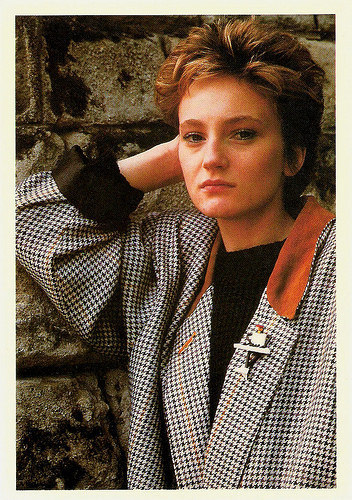
British postcard by New Line, no. 115.
Throaty, smoky voice
Patricia Kaas was born in Forbach, France, in 1966, near the border of Germany. She was the youngest of seven children of miner Joseph Kaas and his wife Irmgard Kaas. Her father was a French Germanophone citizen, and her mother a West German citizen from Saar.
Until the age of six Patricia spoke only Lorraine Franconian. Her mother encouraged Kaas to become a singer at a very young age. At the age of eight Kaas already sang at various small events; among others the marriage of her brother.
Her first great success came when she received first place at a pop song contest. At her first appearances Kaas was already displaying the throaty, smoky voice that would lead to comparisons with Édith Piaf and Marlene Dietrich . Kaas took her first step into the professional music business at the age of 13, when, with the help of her brother Egon, she signed a contract with the Saarbrücken Club Rumpelkammer. Kaas took the name Pady Pax, after the brass band Pax Majorettes, of which she and her sister Carine were members, and for seven years appeared with the band Dob's Lady Killers.
At 16 she took a placement with a model agency in Metz. Kaas' first attempts to break into the music business once and for all initially failed, however; a producer rejected her on the grounds that the world did not need a second Mireille Mathieu . Architect Bernard Schwartz introduced the 19-years-old to the songwriter François Bernheim who worked with her and convinced Gérard Depardieu to produce her music.
In 1985, Depardieu produced Kaas' first single Jalouse (Jealous), written by Bernheim and Depardieu's wife Elisabeth. The single was published by EMI, but was a flop. Nonetheless, her encounter with Depardieu was an important event in the beginning of Kaas' artistic career.
French songwriter Didier Barbelivien became aware of Kaas. His song Mademoiselle chante le blues (Lady sings the blues) was the singer's first big hit. The single was published in 1987 by Polydor, and reached 7th place in the French singles chart.
The next year Kaas' second single D'Allemagne (From Germany) was recorded, written by Barbelivien and Bernheim. Shortly afterwards Kaas' first album Mademoiselle chante... was produced. It reached 2nd place in the French album charts and stayed there for two months, remaining in the Top 10 for 64 weeks and 118 weeks in the top 100. Shortly after its appearance the album went gold in France (over 100,000 sold) and after three months it went platinum (over 350,000 sold). The album also went platinum in Belgium and Switzerland, and gold in Canada.
In the same year Kaas won one of the most important French music awards, the Victoires de la Musique in the category of Discovery of the Year. In 1989, Kaas suffered a traumatic personal experience when her mother fell ill from cancer and died. The teddy bear Kaas sent to support her mother's convalescence today accompanies Kaas everywhere as a mascot.
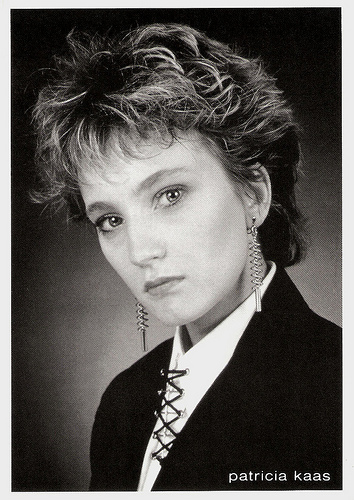
French postcard, no. 134.
I address thee as you
In 1990, Patricia Kaas began her first world tour which lasted 16 months in total. She sang in front of about 750,000 fans in over 196 concerts in 12 countries. Kaas sang daily for a week at the Olympia in Paris, and gave successful concerts in New York and Washington D.C. At the end of the tour, Mademoiselle chante... had sold 1 million copies in France alone.
In 1990, Kaas moved from her former record company Polydor to CBS/Sony. Cyril Prieur and Richard Walter of the firm Talent Sorcier from Paris replaced Bernard Schwartz to become her managers in 1987. Prieur and Walter contributed significantly to the singer's success, in return for which Kaas referred to them as her ‘family’.
She produced Scène de vie (The Stage of Life) in 1990. It reached the top of the French charts and stayed there for 10 weeks. With the song Kennedy Rose, Kaas again worked with Elisabeth Depardieu and François Bernheim. The song was dedicated to Rose Kennedy, matriarch of the Kennedy clan and mother of former U.S. president John F. Kennedy.
While on the Scène de vie tour, the singer performed 210 concerts before 650,000 spectators in 13 countries, among them Japan, Canada and the USSR, where she sang in Moscow and Leningrad. At the end of 1991 her first live album Carnets de scène (Stage Notebooks) appeared.
Kaas' 1993 album Je te dis vous (I address thee as you, also named Tour de Charme) was her definitive breakthrough in the international music scene, selling 3 million copies in 47 countries. It was produced in Pete Townshend's Eel Pie Studio in London, England by Robin Millar, who had already worked for Sade and the Fine Young Cannibals.
On the album Kaas sang her first song in German: Ganz und gar (Absolutely), by Marius Müller-Westernhagen. The album also featured three tracks in English, including a cover of the James Brown number It's A Man's World. The British rock musician Chris Rea accompanied Kaas on the tracks Out Of The Rain and Ceux qui n'ont rien (Those who have nothing) on guitar.
Je te dis vous was a successful album in the German-speaking world, and with the single Il me dit que je suis belle (He tells me I'm beautiful) by Sam Brewski (aka Jean-Jacques Goldman) Kaas achieved her second top five single in France. The song was used by director Bertrand Tavernier in his film L'appât/The bait (1995). The Je te dis vous world tour covered 19 countries including Vietnam, Cambodia, Japan, Korea and Thailand.
Kaas sang the title song to the film Les Misérables (Claude Lelouch, 1995), based on the novel of the same name by Victor Hugo. In the middle of the 1990s the album Black Coffee was produced, an enigma in Kaas' career. The title track of the album is a cover version of the Billie Holiday song and other cover versions on the album include classics such as Bill Withers' Ain't No Sunshine and If You Leave Me Now by Chicago.
In 1997 Dans ma chair (In my flesh) was made. It was produced in New York by Kaas and Phil Ramone, who had previously worked with Ray Charles, Billy Joel and Paul Simon. The album marked the second time the singer officially worked with the French songwriter Jean-Jacques Goldman. The collaboration with Goldman, which continues to this day, was one of the most important of Kaas' career. Further contributors were Lyle Lovett and James Taylor.
In 1999 Le mot de passe (The password) was produced by Pascal Obispo, on which Kaas was accompanied by an orchestra on several tracks. Jean-Jacques Goldman again contributed songs for the studio album. In 2000, Kaas decided to live in Zürich, Switzerland from then on. This also had consequences for her management, which likewise moved from Paris to Zürich and renamed itself International Talent Consulting. Cyril Prieur and Richard Walter remained by Kaas' side.
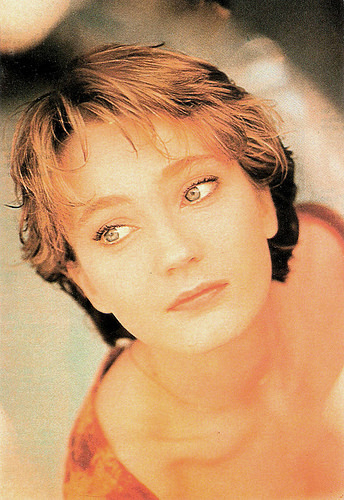
French postcard, no. C 139.
Strong gender
In 2001, Patricia Kaas began her acting career with And now... Ladies and Gentlemen (Claude Lelouch, 2001). She played the burned-out jazz singer Jane beside Jeremy Irons. The film was shown at the Cannes Film Festival, but fared poorly at the box office.
Todd Kristel at AllMovie : “there isn't a lot of heat between the two leads, the supporting characters are underdeveloped (and their story lines are distracting), the film's tone fluctuates unevenly from one scene to the next, and there's not much narrative drive to this movie. The end result is an attractive-looking motion picture that isn't fully satisfying emotionally.”
To accompany the film, the concept album Piano Bar By Patricia Kaas was released in 2002. While not a soundtrack to the film, some songs performed from the film were included on the album in slightly different versions. Piano Bar... was Kaas' first album mainly in English, and is a homage to the great French chanson artists, including an English version of Jacques Brel 's Ne me quitte pas, If You Go Away. The album in France reached 10th place in the charts, but it was the second most successful of Kaas' albums in Germany.
In 2003, the album Sexe fort (Strong gender), reached the 9th place in France. Again Jean-Jacques Goldman and Pascal Obispo contributed songs. At the end of that year, she received the First Class Order of Merit of the Federal Republic of Germany for her contribution to friendship between France and Germany.
Until the end of 2005 Kaas was on what was now her seventh world tour for which she gave 175 concerts before more than 500,000 spectators. Despite the relative failure of Sexe fort, the tour was a huge success.
After a long break, Kaas released in 2008 the song Ne pozvonish' (You Will Not Call) with the Russian rock group Uma2rman, which was a big hit in Russia. The new double album, Kabaret was released in 2009, and to support the album she went on a lengthy international tour.
In 2009, Kaas represented France in the Eurovision Song Contest 2009 in Moscow, Russia. Her song was Et s'il fallait le faire (And if it had to be done) and she finished in 8th place. In 2011, Kaas’ autobiography L’Ombre de ma Voix (The Shadow of My Voice) was published, and has since then been translated into more than 6 languages.
Her next album Kaas chante Piaf (Kaas Sings Piaf, 2012) with 21 Édith Piaf ’ songs, arranged by Abel Korzeniowski, who also composed the music for Madonna’s W.E..
Patricia Kaas played a woman whose daughter is murdered in the TV film Assassinée/Murdered (Thierry Binisti, 2012). The film was highly popular in France when it made its TV debut and Kaas got good reviews for her role. Documentary maker portrayed her for the German TV documentary Patricia Kaas – my life/ma vie.
Since 1988, Kaas has sold over 16 million records worldwide. About her private life, there is no information at the web.
Clip of Patricia Kaas' Il Me Dit Que Je Suis Belle. Source: PKaasOfficiel (YouTube).
Official US trailer And now... Ladies and Gentlemen (Claude Lelouch, 2001). Source: Movieclips (YouTube).
Clip of Paricia Kaas' song Kabaret. Source: PKaasOfficiel (YouTube).
Sources: Johanna Ouwerling (Patricia Kaas Forever), Jason Ankeny (AllMusic), Todd Kristel (AllMovie), Wikipedia and .

British postcard by New Line, no. 115.
Throaty, smoky voice
Patricia Kaas was born in Forbach, France, in 1966, near the border of Germany. She was the youngest of seven children of miner Joseph Kaas and his wife Irmgard Kaas. Her father was a French Germanophone citizen, and her mother a West German citizen from Saar.
Until the age of six Patricia spoke only Lorraine Franconian. Her mother encouraged Kaas to become a singer at a very young age. At the age of eight Kaas already sang at various small events; among others the marriage of her brother.
Her first great success came when she received first place at a pop song contest. At her first appearances Kaas was already displaying the throaty, smoky voice that would lead to comparisons with Édith Piaf and Marlene Dietrich . Kaas took her first step into the professional music business at the age of 13, when, with the help of her brother Egon, she signed a contract with the Saarbrücken Club Rumpelkammer. Kaas took the name Pady Pax, after the brass band Pax Majorettes, of which she and her sister Carine were members, and for seven years appeared with the band Dob's Lady Killers.
At 16 she took a placement with a model agency in Metz. Kaas' first attempts to break into the music business once and for all initially failed, however; a producer rejected her on the grounds that the world did not need a second Mireille Mathieu . Architect Bernard Schwartz introduced the 19-years-old to the songwriter François Bernheim who worked with her and convinced Gérard Depardieu to produce her music.
In 1985, Depardieu produced Kaas' first single Jalouse (Jealous), written by Bernheim and Depardieu's wife Elisabeth. The single was published by EMI, but was a flop. Nonetheless, her encounter with Depardieu was an important event in the beginning of Kaas' artistic career.
French songwriter Didier Barbelivien became aware of Kaas. His song Mademoiselle chante le blues (Lady sings the blues) was the singer's first big hit. The single was published in 1987 by Polydor, and reached 7th place in the French singles chart.
The next year Kaas' second single D'Allemagne (From Germany) was recorded, written by Barbelivien and Bernheim. Shortly afterwards Kaas' first album Mademoiselle chante... was produced. It reached 2nd place in the French album charts and stayed there for two months, remaining in the Top 10 for 64 weeks and 118 weeks in the top 100. Shortly after its appearance the album went gold in France (over 100,000 sold) and after three months it went platinum (over 350,000 sold). The album also went platinum in Belgium and Switzerland, and gold in Canada.
In the same year Kaas won one of the most important French music awards, the Victoires de la Musique in the category of Discovery of the Year. In 1989, Kaas suffered a traumatic personal experience when her mother fell ill from cancer and died. The teddy bear Kaas sent to support her mother's convalescence today accompanies Kaas everywhere as a mascot.

French postcard, no. 134.
I address thee as you
In 1990, Patricia Kaas began her first world tour which lasted 16 months in total. She sang in front of about 750,000 fans in over 196 concerts in 12 countries. Kaas sang daily for a week at the Olympia in Paris, and gave successful concerts in New York and Washington D.C. At the end of the tour, Mademoiselle chante... had sold 1 million copies in France alone.
In 1990, Kaas moved from her former record company Polydor to CBS/Sony. Cyril Prieur and Richard Walter of the firm Talent Sorcier from Paris replaced Bernard Schwartz to become her managers in 1987. Prieur and Walter contributed significantly to the singer's success, in return for which Kaas referred to them as her ‘family’.
She produced Scène de vie (The Stage of Life) in 1990. It reached the top of the French charts and stayed there for 10 weeks. With the song Kennedy Rose, Kaas again worked with Elisabeth Depardieu and François Bernheim. The song was dedicated to Rose Kennedy, matriarch of the Kennedy clan and mother of former U.S. president John F. Kennedy.
While on the Scène de vie tour, the singer performed 210 concerts before 650,000 spectators in 13 countries, among them Japan, Canada and the USSR, where she sang in Moscow and Leningrad. At the end of 1991 her first live album Carnets de scène (Stage Notebooks) appeared.
Kaas' 1993 album Je te dis vous (I address thee as you, also named Tour de Charme) was her definitive breakthrough in the international music scene, selling 3 million copies in 47 countries. It was produced in Pete Townshend's Eel Pie Studio in London, England by Robin Millar, who had already worked for Sade and the Fine Young Cannibals.
On the album Kaas sang her first song in German: Ganz und gar (Absolutely), by Marius Müller-Westernhagen. The album also featured three tracks in English, including a cover of the James Brown number It's A Man's World. The British rock musician Chris Rea accompanied Kaas on the tracks Out Of The Rain and Ceux qui n'ont rien (Those who have nothing) on guitar.
Je te dis vous was a successful album in the German-speaking world, and with the single Il me dit que je suis belle (He tells me I'm beautiful) by Sam Brewski (aka Jean-Jacques Goldman) Kaas achieved her second top five single in France. The song was used by director Bertrand Tavernier in his film L'appât/The bait (1995). The Je te dis vous world tour covered 19 countries including Vietnam, Cambodia, Japan, Korea and Thailand.
Kaas sang the title song to the film Les Misérables (Claude Lelouch, 1995), based on the novel of the same name by Victor Hugo. In the middle of the 1990s the album Black Coffee was produced, an enigma in Kaas' career. The title track of the album is a cover version of the Billie Holiday song and other cover versions on the album include classics such as Bill Withers' Ain't No Sunshine and If You Leave Me Now by Chicago.
In 1997 Dans ma chair (In my flesh) was made. It was produced in New York by Kaas and Phil Ramone, who had previously worked with Ray Charles, Billy Joel and Paul Simon. The album marked the second time the singer officially worked with the French songwriter Jean-Jacques Goldman. The collaboration with Goldman, which continues to this day, was one of the most important of Kaas' career. Further contributors were Lyle Lovett and James Taylor.
In 1999 Le mot de passe (The password) was produced by Pascal Obispo, on which Kaas was accompanied by an orchestra on several tracks. Jean-Jacques Goldman again contributed songs for the studio album. In 2000, Kaas decided to live in Zürich, Switzerland from then on. This also had consequences for her management, which likewise moved from Paris to Zürich and renamed itself International Talent Consulting. Cyril Prieur and Richard Walter remained by Kaas' side.

French postcard, no. C 139.
Strong gender
In 2001, Patricia Kaas began her acting career with And now... Ladies and Gentlemen (Claude Lelouch, 2001). She played the burned-out jazz singer Jane beside Jeremy Irons. The film was shown at the Cannes Film Festival, but fared poorly at the box office.
Todd Kristel at AllMovie : “there isn't a lot of heat between the two leads, the supporting characters are underdeveloped (and their story lines are distracting), the film's tone fluctuates unevenly from one scene to the next, and there's not much narrative drive to this movie. The end result is an attractive-looking motion picture that isn't fully satisfying emotionally.”
To accompany the film, the concept album Piano Bar By Patricia Kaas was released in 2002. While not a soundtrack to the film, some songs performed from the film were included on the album in slightly different versions. Piano Bar... was Kaas' first album mainly in English, and is a homage to the great French chanson artists, including an English version of Jacques Brel 's Ne me quitte pas, If You Go Away. The album in France reached 10th place in the charts, but it was the second most successful of Kaas' albums in Germany.
In 2003, the album Sexe fort (Strong gender), reached the 9th place in France. Again Jean-Jacques Goldman and Pascal Obispo contributed songs. At the end of that year, she received the First Class Order of Merit of the Federal Republic of Germany for her contribution to friendship between France and Germany.
Until the end of 2005 Kaas was on what was now her seventh world tour for which she gave 175 concerts before more than 500,000 spectators. Despite the relative failure of Sexe fort, the tour was a huge success.
After a long break, Kaas released in 2008 the song Ne pozvonish' (You Will Not Call) with the Russian rock group Uma2rman, which was a big hit in Russia. The new double album, Kabaret was released in 2009, and to support the album she went on a lengthy international tour.
In 2009, Kaas represented France in the Eurovision Song Contest 2009 in Moscow, Russia. Her song was Et s'il fallait le faire (And if it had to be done) and she finished in 8th place. In 2011, Kaas’ autobiography L’Ombre de ma Voix (The Shadow of My Voice) was published, and has since then been translated into more than 6 languages.
Her next album Kaas chante Piaf (Kaas Sings Piaf, 2012) with 21 Édith Piaf ’ songs, arranged by Abel Korzeniowski, who also composed the music for Madonna’s W.E..
Patricia Kaas played a woman whose daughter is murdered in the TV film Assassinée/Murdered (Thierry Binisti, 2012). The film was highly popular in France when it made its TV debut and Kaas got good reviews for her role. Documentary maker portrayed her for the German TV documentary Patricia Kaas – my life/ma vie.
Since 1988, Kaas has sold over 16 million records worldwide. About her private life, there is no information at the web.
Clip of Patricia Kaas' Il Me Dit Que Je Suis Belle. Source: PKaasOfficiel (YouTube).
Official US trailer And now... Ladies and Gentlemen (Claude Lelouch, 2001). Source: Movieclips (YouTube).
Clip of Paricia Kaas' song Kabaret. Source: PKaasOfficiel (YouTube).
Sources: Johanna Ouwerling (Patricia Kaas Forever), Jason Ankeny (AllMusic), Todd Kristel (AllMovie), Wikipedia and .
Published on November 23, 2014 01:56
November 21, 2014
Maciste all’Inferno (1926)
Maciste all’Inferno/Maciste in Hell (Guido Brignone, 1926) once inspired the young Federico Fellini to become a film director. He loved the silent film because of its weird, fairy-tale-like atmosphere. Italian actor Bartolomeo Pagano played the strong man Maciste for the first time in Cabiria (Giovanni Pastrone, 1914). The enormous success of that film classic launched a series of Maciste films, produced in Italy and Germany.
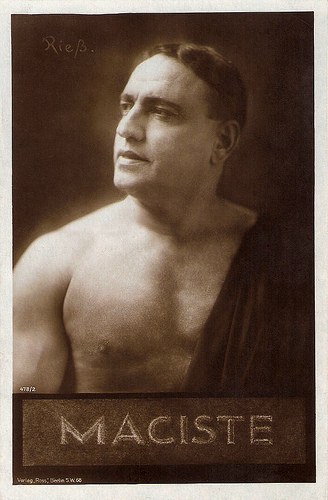
Bartolomeo Pagano alias Maciste. German postcard by Ross Verlag, no. 478/2, 1919-1924. Photo: Riess.

Bartolomeo Pagano alias Maciste. German postcard by Ross Verlag, no. 478/1, 1919-1924. Photo: Riess.
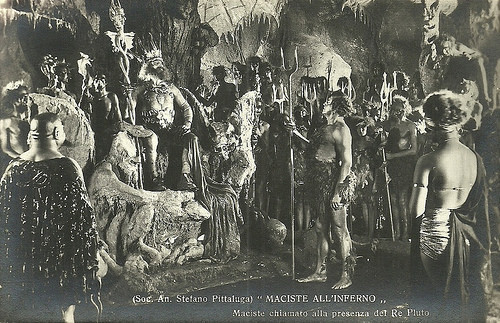
Italian postcard by Ed. A. Traldi, Milano. Photo: Dist. Società Anonima Stefano Pittaluga. Publicity still for Maciste all'inferno (Guido Brignone 1926). Caption: "Maciste ( Bartolomeo Pagano ) called before king Pluto (Umberto Guarracino)". At the right, seen on the back, Pluto's daughter Luciferina (Lucia Zanussi) is standing. The bold guy on the left must be Gerione (Mario Saio).

Italian postcard by Ed. A. Traldi, Milano. Photo: Dist. Società Anonima Stefano Pittaluga. Publicity still for Maciste all'inferno (Guido Brignone 1926), starring Bartolomeo Pagano as Maciste. Caption: "The Tomb of the Heresiarchs [heretics]."
A call for Maciste
In 1913, film director and producer Giovanni Pastrone, manager of the Itala company of Turin, released a call for the interpreter of the character of the Nubic slave Maciste (a character created together with Gabriele D’Annunzio) for Pastrone’s super-production Cabiria (1914).
Out of 50 candidates from all over Italy, Pastrone selected Bartolomeo Pagano . According to another version, it was actor Domenico Gambino who noticed Pagano and signalled him to Pastrone, who, impressed by his physique, hired him for his epic film.
Overnight Pagano became an international success because of his physique and his image of courageous, humorous and no-nonsensical defender of the weak. In Cabiria he uses his power to rescue a Roman girl out of the hands of the Carthaginian priests who want to offer her to Moloch.
Pastrone immediately saw opportunities and launched a series of films just around his character, starting with a film just called Maciste (1915). Deliberately, Maciste’s part in Cabiria, the splendour of the Itala studio, and Maciste’s work there, were shown to impress audiences and tie them to the previous box office hit.
Of course the plot deals with a damsel in distress, whom Maciste saves with his muscles and his wit. During the First World War Pastrone used Maciste for war propaganda in Maciste alpino (1916), in which Maciste fiercely opposes the Austrian soldiers when he and his colleagues are captured during a film shoot on location.
The success of the film made Pastrone exploit Maciste in all kinds of situations and genres, but mostly in the adventure and crime genre: Maciste medium, Maciste atleta, Maciste poliziotto (all 1918), Maciste innamorato (1919), La trilogia di Maciste (1920), Maciste salvato dalle acque, Maciste in vacanza (both 1921).
By now Pastrone did not direct the films anymore but left this task to skilled directors like Luigi Romano Borgnetto. While not all of these were good productions, a better example was La Trilogia di Maciste by Carlo Campogalliani.
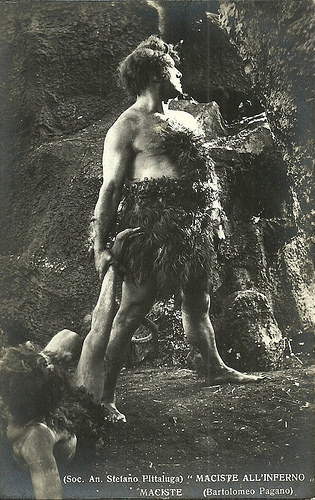
Italian postcard by Ed. A. Traldi, Milano. Photo: Dist. Società Anonima Stefano Pittaluga. Bartolomeo Pagano as Maciste in Maciste all'inferno (Guido Brignone, 1926).
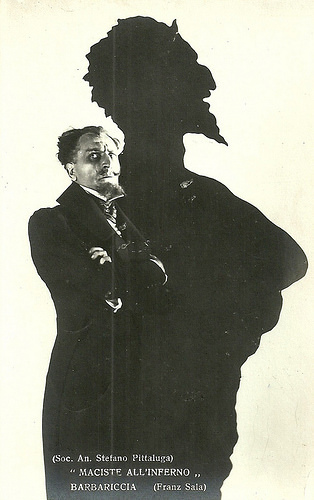
Italian postcard by Ed. A. Traldi, Milano. Photo: Dist. Società Anonima Stefano Pittaluga. Franz Sala as the devil Barbariccia in Maciste all’inferno (Guido Brigone, 1926). Franz Sala aka Francesco Sala (1886-1952) was a prolific actor of the Italian silent cinema, mostly playing the evil antagonist. In the 1930s he was active as makeup artist.
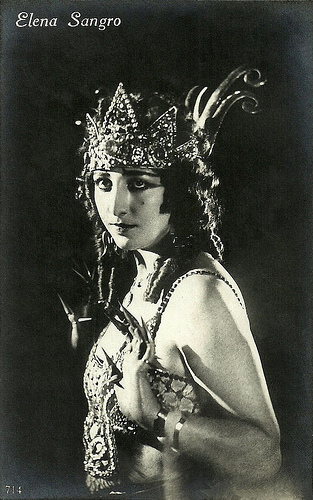
Italian postcard by Ed. A. Traldi, Milano, no. 714. Photo: Dist. Società Anonima Stefano Pittaluga. Elena Sangro as Proserpina, wife of Pluto, king of the underworld, in Maciste all'inferno (Guido Brignone, 1926).
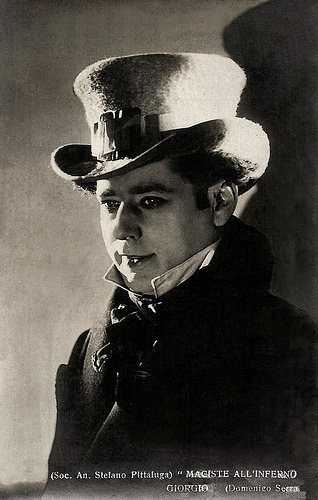
Italian postcard by Ed. A. Traldi, Milano. Photo: Dist. Società Anonima Stefano Pittaluga. Domenico Serra as Giorgio in Maciste all'inferno (Guido Brignone 1925).
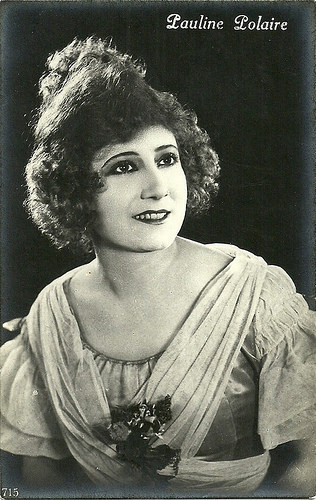
Italian postcard by Ed. A. Traldi, Milano, no. 715. Photo: Dist. Società Anonima Stefano Pittaluga. Pauline Polaire in Maciste all'inferno (Guido Brignone, 1926).
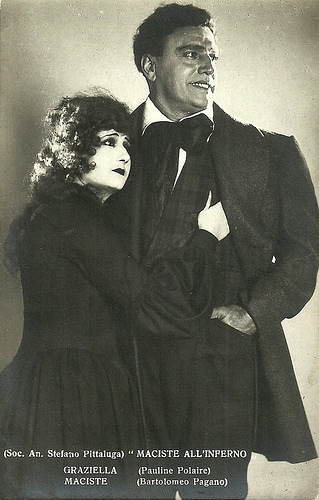
Italian postcard by Ed. A. Traldi, Milano. Photo: Dist. Società Anonima Stefano Pittaluga. Publicity still for Maciste all'inferno (Guido Brignone, 1926), starring Bartolomeo Pagano as Maciste and Pauline Polaire as Graziella.
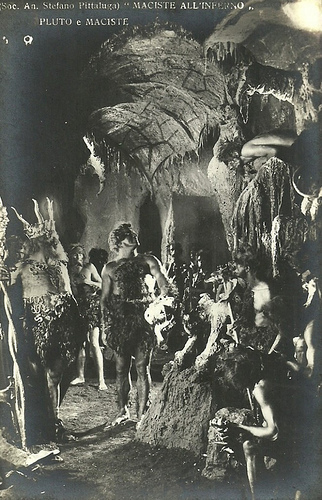
Italian postcard by Ed. A. Traldi, Milano. Photo: Dist. Società Anonima Stefano Pittaluga. Publicity still for Maciste all'inferno (Guido Brignone, 1926), starring Bartolomeo Pagano as Maciste and Umberto Guarracino as King Pluto.
The outside world didn’t know
In Italy a strong man or forzuti genre in film sprang up, creating space for characters such as Ausonia, Galaor, Ajax, and Sansone, and attracting competing strong men and physical culture champions such as Giovanni Raicevich.
Pagano’s Maciste was also simply pirated abroad, such as by the French actor Michel Bonnet with his character Magiste, and another rip-off in Mexico. French critic Louis Delluc called him the Guitry of biceps, while newcomers Ultus ( Aurele Sydney ) and Douglas Fairbanks were launched as the British and the American Maciste.
In the late 1910s and early 1920s Maciste’s popularity was biggest in Austria and Germania, despite the preceding anti-Austrian Maciste alpino. At home in Italy, Maciste’s image of superman coincided with the new fascist ideology. In the 1920s Pagano was one of the best paid actors of his times, sometimes gaining 600.000 lire a year.
The Maciste-films continued until the early-1920s, when, not so much because of the collapse of the Italian film production but rather because of a fabulous contract, Pagano went to Berlin, the mecca of the European film industry. Here he stayed between 1921 and 1923, but according to the film press he wasn’t as successful there as in Italy.
He played in Maciste und die Javanerin (Uwe Jenss Kraft, 1921), Maciste und die Tochter des Silberkönig (Luigi Romano Borgnetto, 1921), Maciste und der Sträfling Nr. 51 (Luigi Romano Borgnetto 1921), and Maciste und die Chinesische Truhe (Carl Boese, 1923).
Dissatisfied Pagano returned to Italy, where producer Stefano Pittaluga immediately put him on a transatlantic for the film Maciste e il nipote d’America (Eleuterio Rodolfi, 1924), which included scenes shot in New York.
Among less convincing titles such as Maciste imperatore (Guido Brignone), the same Brignone directed Pagano in Maciste all’Inferno (Guido Brignone, 1926), a witty and artful pastiche on Dante, Doré, Méliès, Expressionism and medieval illustrations. It also contains ingenious special effects by ‘magician’ Segundo de Chomon.
The devil takes Maciste down to hell in an attempt to corrupt and ruin his morality.
When entering Hades, Maciste is being seduced by Proserpina, played by Italian diva Elena Sangro , and he turns into a hairy devil himself. The film was dear to Federico Fellini, because of its weird, fairy-tale-like atmosphere; the film supposedly inspired him to become film director.
Bored with his Maciste films, Pagano asked and got different roles: Il vetturale del Moncenisio (Baldassarre Negroni, 1927), Giuditta e Oloferne (1928) starring Jia Ruskaja, and his last part (a secondary one by now) in L’ultimo Zar (Baldassarre Negroni, 1928).
Afflicted by diabetes, though, Pagano withdrew to his Villa Maciste in Sant’Ilario Ligure near Genua. Physical mishap destroyed his forces, typhoid reduced his weight in drastic ways, while arthritis even obliged him to spend his last years in a wheelchair. The outside world didn’t know.
Bartolomeo Pagano died in Genua on 24 June 1947, because of a heart attack. According to Italian film historian Vittorio Martinelli, Pagano never was a real actor, but rather the lively personification of a character from popular literature.
His character’s name though remains as synonym for power and courage. In 1960-1965 Maciste was revived in the sword and sandal films with Mark Forrest, Gordon Scott, Kirk Morris, Ed Fury and other bodybuilders, while in the early 1970s Jesus Franco made two low-budget Maciste-films for French producers.
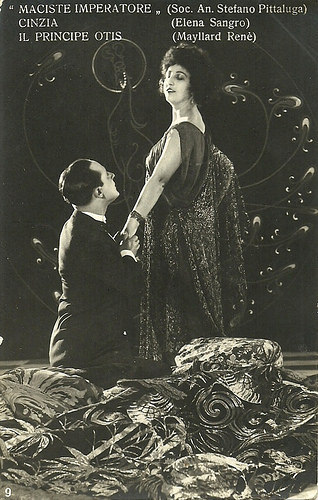
Italian postcard by Ed. A. Traldi, Milano, no. 9. Photo: Dist. Società Anonima Stefano Pittaluga. Elena Sangro as Cinzia and René [Raoul] Mayllard as prince Otis [Ortis]in the Fert production Maciste imperatore (Guido Brignone, 1924). In the kingdom of Sindagna, the prince regent Stanos tries with all means to dispose of the legitimate heir to the throne, prince Ortis. When Maciste and Saetta happen to be in the chaotic empire, they set things straight for the poor, weak prince. Maciste is proclaimed emperor of Sindagna after getting rid of the regent and his puppet ruler, restores peace, and arranges that the prince can also be united with his beloved one. The plot line comes close Mussolini's take over of Italy, 'helping' the weak king Victor Emmanuel III and 'restoring order'.
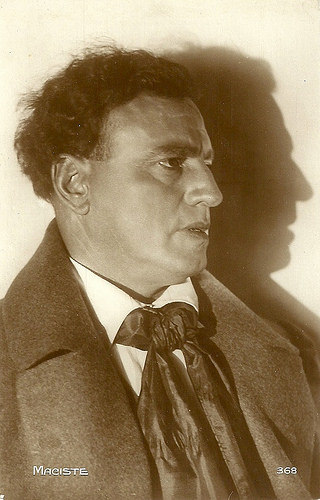
French postcard by Editions Cinémagazine, no. 368. Bartolomeo Pagano aka Maciste in Maciste all'inferno (Guido Brignone, 1926).
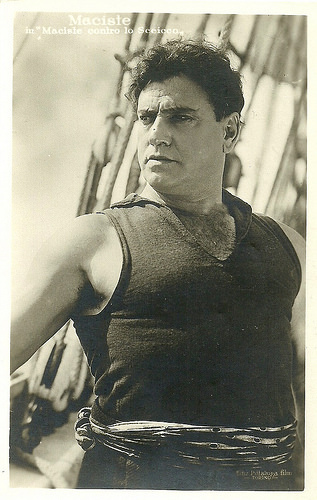
Italian postcard. Photo: Pittaluga Film, Turin. Maciste ( Bartolomeo Pagano ) in Maciste contro lo sceicco/Maciste against the Sheik (Mario Camerini, 1926).
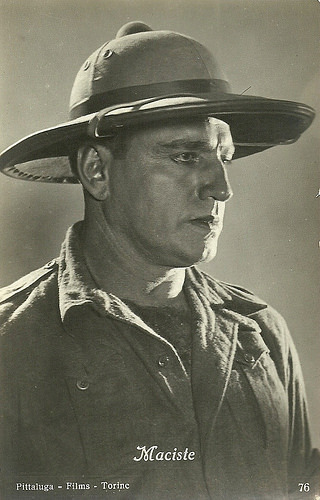
Italian postcard by Ed. A. Traldi, Milano, no. 76. Photo: Pittaluga Film, Turin. Maciste ( Bartolomeo Pagano ) in Maciste nella gabbia dei leoni/Maciste in the Lion's cage (Guido Brignone, 1926).
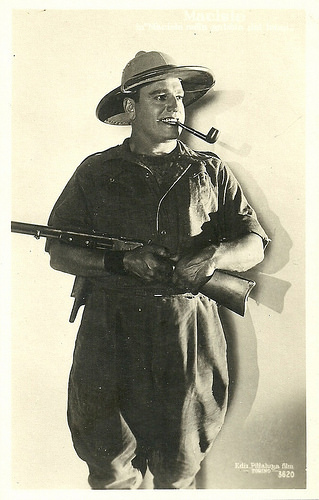
Italian postcard. Photo: Pittaluga Film, Turin. Maciste ( Bartolomeo Pagano ) in Maciste nella gabbia dei leoni/Maciste in the Lion's cage (Guido Brignone, 1926).
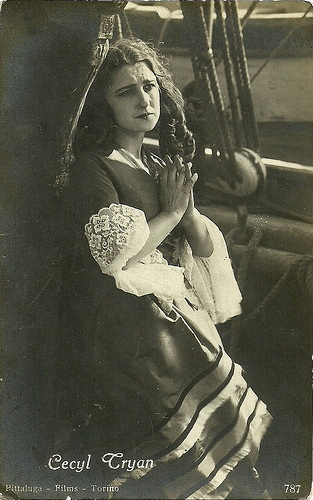
Italian postcard by Ed. A. Traldi, Milano, no. 787. Photo: Dist. Società Anonima Stefano Pittaluga. Cecyl Tryan in the Fert production Maciste contro lo sceicco/Maciste against the Sheik (Mario Camerini, 1926). Cecyl Tryan is the young girl whose tutor (Franz Sala) and his spendthrift mistress (Rita d'Harcourt) want to steal her inheritance, and sell her to a sheik. Aboard the ship she is menaced by the crew but a young sailor ( Lido Manetti ) and Maciste ( Bartolomeo Pagano ) rescue her. In the harbour the sheik manages to abduct the girl and place her in his harem, but Maciste and the young man use power and wits to liberate her, defeat the sheik and sail back to Italy to set things straight there too.
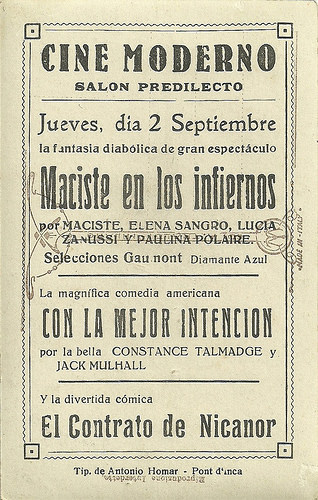
Spanish version of Italian postcard. Retro announcing Maciste all'inferno (Guido Brignone, 1926) at the Cine Moderno. Tipografia de Antonio Homar. Pont d'Inca. Thursday 2 September refers to the year 1926.
Sources: Vittorio Martinelli (Maciste & Co. I giganti buoni del cinema italiano - Italian), Wikipedia (Italian) and IMDb.

Bartolomeo Pagano alias Maciste. German postcard by Ross Verlag, no. 478/2, 1919-1924. Photo: Riess.

Bartolomeo Pagano alias Maciste. German postcard by Ross Verlag, no. 478/1, 1919-1924. Photo: Riess.

Italian postcard by Ed. A. Traldi, Milano. Photo: Dist. Società Anonima Stefano Pittaluga. Publicity still for Maciste all'inferno (Guido Brignone 1926). Caption: "Maciste ( Bartolomeo Pagano ) called before king Pluto (Umberto Guarracino)". At the right, seen on the back, Pluto's daughter Luciferina (Lucia Zanussi) is standing. The bold guy on the left must be Gerione (Mario Saio).

Italian postcard by Ed. A. Traldi, Milano. Photo: Dist. Società Anonima Stefano Pittaluga. Publicity still for Maciste all'inferno (Guido Brignone 1926), starring Bartolomeo Pagano as Maciste. Caption: "The Tomb of the Heresiarchs [heretics]."
A call for Maciste
In 1913, film director and producer Giovanni Pastrone, manager of the Itala company of Turin, released a call for the interpreter of the character of the Nubic slave Maciste (a character created together with Gabriele D’Annunzio) for Pastrone’s super-production Cabiria (1914).
Out of 50 candidates from all over Italy, Pastrone selected Bartolomeo Pagano . According to another version, it was actor Domenico Gambino who noticed Pagano and signalled him to Pastrone, who, impressed by his physique, hired him for his epic film.
Overnight Pagano became an international success because of his physique and his image of courageous, humorous and no-nonsensical defender of the weak. In Cabiria he uses his power to rescue a Roman girl out of the hands of the Carthaginian priests who want to offer her to Moloch.
Pastrone immediately saw opportunities and launched a series of films just around his character, starting with a film just called Maciste (1915). Deliberately, Maciste’s part in Cabiria, the splendour of the Itala studio, and Maciste’s work there, were shown to impress audiences and tie them to the previous box office hit.
Of course the plot deals with a damsel in distress, whom Maciste saves with his muscles and his wit. During the First World War Pastrone used Maciste for war propaganda in Maciste alpino (1916), in which Maciste fiercely opposes the Austrian soldiers when he and his colleagues are captured during a film shoot on location.
The success of the film made Pastrone exploit Maciste in all kinds of situations and genres, but mostly in the adventure and crime genre: Maciste medium, Maciste atleta, Maciste poliziotto (all 1918), Maciste innamorato (1919), La trilogia di Maciste (1920), Maciste salvato dalle acque, Maciste in vacanza (both 1921).
By now Pastrone did not direct the films anymore but left this task to skilled directors like Luigi Romano Borgnetto. While not all of these were good productions, a better example was La Trilogia di Maciste by Carlo Campogalliani.

Italian postcard by Ed. A. Traldi, Milano. Photo: Dist. Società Anonima Stefano Pittaluga. Bartolomeo Pagano as Maciste in Maciste all'inferno (Guido Brignone, 1926).

Italian postcard by Ed. A. Traldi, Milano. Photo: Dist. Società Anonima Stefano Pittaluga. Franz Sala as the devil Barbariccia in Maciste all’inferno (Guido Brigone, 1926). Franz Sala aka Francesco Sala (1886-1952) was a prolific actor of the Italian silent cinema, mostly playing the evil antagonist. In the 1930s he was active as makeup artist.

Italian postcard by Ed. A. Traldi, Milano, no. 714. Photo: Dist. Società Anonima Stefano Pittaluga. Elena Sangro as Proserpina, wife of Pluto, king of the underworld, in Maciste all'inferno (Guido Brignone, 1926).

Italian postcard by Ed. A. Traldi, Milano. Photo: Dist. Società Anonima Stefano Pittaluga. Domenico Serra as Giorgio in Maciste all'inferno (Guido Brignone 1925).

Italian postcard by Ed. A. Traldi, Milano, no. 715. Photo: Dist. Società Anonima Stefano Pittaluga. Pauline Polaire in Maciste all'inferno (Guido Brignone, 1926).

Italian postcard by Ed. A. Traldi, Milano. Photo: Dist. Società Anonima Stefano Pittaluga. Publicity still for Maciste all'inferno (Guido Brignone, 1926), starring Bartolomeo Pagano as Maciste and Pauline Polaire as Graziella.

Italian postcard by Ed. A. Traldi, Milano. Photo: Dist. Società Anonima Stefano Pittaluga. Publicity still for Maciste all'inferno (Guido Brignone, 1926), starring Bartolomeo Pagano as Maciste and Umberto Guarracino as King Pluto.
The outside world didn’t know
In Italy a strong man or forzuti genre in film sprang up, creating space for characters such as Ausonia, Galaor, Ajax, and Sansone, and attracting competing strong men and physical culture champions such as Giovanni Raicevich.
Pagano’s Maciste was also simply pirated abroad, such as by the French actor Michel Bonnet with his character Magiste, and another rip-off in Mexico. French critic Louis Delluc called him the Guitry of biceps, while newcomers Ultus ( Aurele Sydney ) and Douglas Fairbanks were launched as the British and the American Maciste.
In the late 1910s and early 1920s Maciste’s popularity was biggest in Austria and Germania, despite the preceding anti-Austrian Maciste alpino. At home in Italy, Maciste’s image of superman coincided with the new fascist ideology. In the 1920s Pagano was one of the best paid actors of his times, sometimes gaining 600.000 lire a year.
The Maciste-films continued until the early-1920s, when, not so much because of the collapse of the Italian film production but rather because of a fabulous contract, Pagano went to Berlin, the mecca of the European film industry. Here he stayed between 1921 and 1923, but according to the film press he wasn’t as successful there as in Italy.
He played in Maciste und die Javanerin (Uwe Jenss Kraft, 1921), Maciste und die Tochter des Silberkönig (Luigi Romano Borgnetto, 1921), Maciste und der Sträfling Nr. 51 (Luigi Romano Borgnetto 1921), and Maciste und die Chinesische Truhe (Carl Boese, 1923).
Dissatisfied Pagano returned to Italy, where producer Stefano Pittaluga immediately put him on a transatlantic for the film Maciste e il nipote d’America (Eleuterio Rodolfi, 1924), which included scenes shot in New York.
Among less convincing titles such as Maciste imperatore (Guido Brignone), the same Brignone directed Pagano in Maciste all’Inferno (Guido Brignone, 1926), a witty and artful pastiche on Dante, Doré, Méliès, Expressionism and medieval illustrations. It also contains ingenious special effects by ‘magician’ Segundo de Chomon.
The devil takes Maciste down to hell in an attempt to corrupt and ruin his morality.
When entering Hades, Maciste is being seduced by Proserpina, played by Italian diva Elena Sangro , and he turns into a hairy devil himself. The film was dear to Federico Fellini, because of its weird, fairy-tale-like atmosphere; the film supposedly inspired him to become film director.
Bored with his Maciste films, Pagano asked and got different roles: Il vetturale del Moncenisio (Baldassarre Negroni, 1927), Giuditta e Oloferne (1928) starring Jia Ruskaja, and his last part (a secondary one by now) in L’ultimo Zar (Baldassarre Negroni, 1928).
Afflicted by diabetes, though, Pagano withdrew to his Villa Maciste in Sant’Ilario Ligure near Genua. Physical mishap destroyed his forces, typhoid reduced his weight in drastic ways, while arthritis even obliged him to spend his last years in a wheelchair. The outside world didn’t know.
Bartolomeo Pagano died in Genua on 24 June 1947, because of a heart attack. According to Italian film historian Vittorio Martinelli, Pagano never was a real actor, but rather the lively personification of a character from popular literature.
His character’s name though remains as synonym for power and courage. In 1960-1965 Maciste was revived in the sword and sandal films with Mark Forrest, Gordon Scott, Kirk Morris, Ed Fury and other bodybuilders, while in the early 1970s Jesus Franco made two low-budget Maciste-films for French producers.

Italian postcard by Ed. A. Traldi, Milano, no. 9. Photo: Dist. Società Anonima Stefano Pittaluga. Elena Sangro as Cinzia and René [Raoul] Mayllard as prince Otis [Ortis]in the Fert production Maciste imperatore (Guido Brignone, 1924). In the kingdom of Sindagna, the prince regent Stanos tries with all means to dispose of the legitimate heir to the throne, prince Ortis. When Maciste and Saetta happen to be in the chaotic empire, they set things straight for the poor, weak prince. Maciste is proclaimed emperor of Sindagna after getting rid of the regent and his puppet ruler, restores peace, and arranges that the prince can also be united with his beloved one. The plot line comes close Mussolini's take over of Italy, 'helping' the weak king Victor Emmanuel III and 'restoring order'.

French postcard by Editions Cinémagazine, no. 368. Bartolomeo Pagano aka Maciste in Maciste all'inferno (Guido Brignone, 1926).

Italian postcard. Photo: Pittaluga Film, Turin. Maciste ( Bartolomeo Pagano ) in Maciste contro lo sceicco/Maciste against the Sheik (Mario Camerini, 1926).

Italian postcard by Ed. A. Traldi, Milano, no. 76. Photo: Pittaluga Film, Turin. Maciste ( Bartolomeo Pagano ) in Maciste nella gabbia dei leoni/Maciste in the Lion's cage (Guido Brignone, 1926).

Italian postcard. Photo: Pittaluga Film, Turin. Maciste ( Bartolomeo Pagano ) in Maciste nella gabbia dei leoni/Maciste in the Lion's cage (Guido Brignone, 1926).

Italian postcard by Ed. A. Traldi, Milano, no. 787. Photo: Dist. Società Anonima Stefano Pittaluga. Cecyl Tryan in the Fert production Maciste contro lo sceicco/Maciste against the Sheik (Mario Camerini, 1926). Cecyl Tryan is the young girl whose tutor (Franz Sala) and his spendthrift mistress (Rita d'Harcourt) want to steal her inheritance, and sell her to a sheik. Aboard the ship she is menaced by the crew but a young sailor ( Lido Manetti ) and Maciste ( Bartolomeo Pagano ) rescue her. In the harbour the sheik manages to abduct the girl and place her in his harem, but Maciste and the young man use power and wits to liberate her, defeat the sheik and sail back to Italy to set things straight there too.

Spanish version of Italian postcard. Retro announcing Maciste all'inferno (Guido Brignone, 1926) at the Cine Moderno. Tipografia de Antonio Homar. Pont d'Inca. Thursday 2 September refers to the year 1926.
Sources: Vittorio Martinelli (Maciste & Co. I giganti buoni del cinema italiano - Italian), Wikipedia (Italian) and IMDb.
Published on November 21, 2014 22:00
November 20, 2014
Marianne Koch
Versatile German actress Marianne Koch (1931) played in more than 65 films between 1950 and 1971. Internationally she is best known as the tormented Marisol, who is saved by Clint Eastwood in the legendary spaghetti-western A Fistful of Dollars (Sergio Leone, 1964).
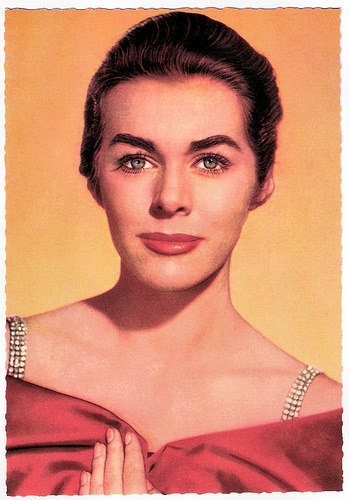
German postcard by ISV, no. G 1.
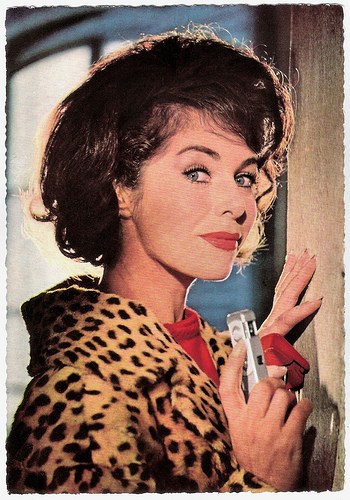
German postcard by Krüger, no. 902/187. Photo: Klaus Collignon.
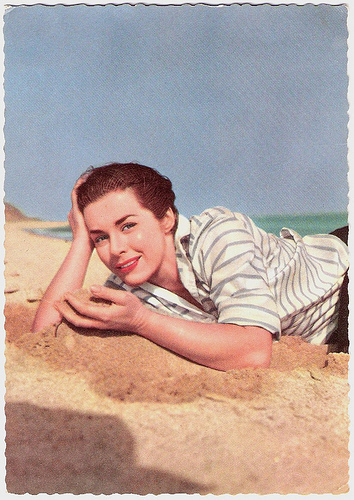
German postcard by Universum-Film Aktiengesellschaft (Ufa), Berlin-Tempelhof, no. CK-36.
Best Supporting Actress of 1955
Marianne Koch was born in Munich, Germany, in 1931. She was the daughter of a businessman and a pianist. As a 10-year old she already played theatre and she was a guest student at the opera school.
In 1949 she started a medical studies at the university of Munich. As a student she made her film debut next to Rudolf Forster and Olga Tschechova in the drama Der Mann, der zweimal leben wollte/The Man Who Wanted to Live Twice (Viktor Tourjansky, 1950).
The following year she made a spontaneous appearance in Dr. Holl/Affairs of Dr. Holl (Rolf Hansen, 1951) with Maria Schell and Dieter Borsche , and in Mein Freund, der Dieb/My Friend, the Thief (Helmut Weiss, 1951) with Hans Söhnker and Hardy Krüger .
She broke off her studies to become an actress full-time. She played her first leading role in the melodrama Wetterleuchten am Dachstein/Storm Clouds over Dachstein (Anton Kutter, 1953). In the American cold war drama Night People (Nunnally Johnson, 1954) she played a supporting part alongside Gregory Peck.
She stayed in Germany and appeared with O. W. Fischer in Ludwig II: Glanz und Ende eines Königs/Mad Emperor: Ludwig II (Helmut Käutner, 1955). For her portrayal of Diddo Geiss in Des Teufels General/The Devil's General (Helmut Käutner, 1955), she received the Filmband in Silber (Film Strip in Silver) for the Best Supporting Actress of 1955.
As Marianne Cook she appeared in the Hollywood productions Four Girls in Town (Jack Sher, 1957) opposite George Nader , and Interlude (Douglas Sirk, 1957) with June Allyson and Rossano Brazzi .
In Germany she played in the comedy Salzburger Geschichten/Salzburg Stories (Kurt Hoffmann, 1957) based on a book by Erich Kästner, and in the war films Der Stern von Afrika/The Star of Africa (Alfred Weidenmann, 1957) with Joachim Hansen , and Der Fuchs von Paris/The Paris Fox (Paul May, 1957) with Hardy Krüger .
In the comedy Vater sein dagegen/To Be A Father On the Contrary (Kurt Meisel, 1957) she appeared as the bride of the almost 30 years older Heinz Rühmann . She also had success as a patent country doctor in Die Landärztin vom Tegernsee/The Country Doctor of Tegernsee (Paul May, 1958).
In Italy she appeared in the comedy Gli italiani sono matti/The Italians They Are Crazy (Duilio Coletti, Luis María Delgado, 1958) starring Hollywood veteran Victor McLaglen .
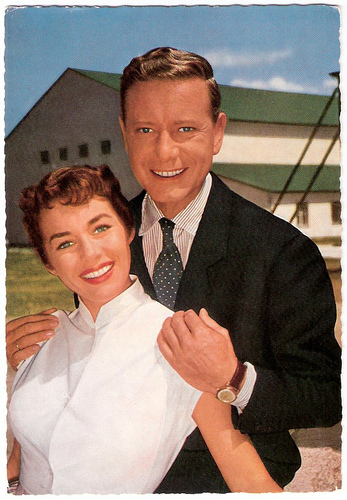
With Dieter Borsche . German postcard by WS-Druck, Wanne-Eickel, no. F 79. Photo: Ringpress / Vogelmann / Bavaria.
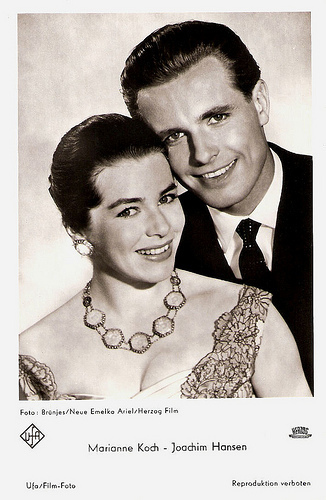
With Joachim Hansen . German postcard by Ufa/Film-Foto, Berlin-Tempelhoff, no. FK 3658. Retail price: 25 Pfg. Photo: Brünjes / Neue Emelka / Herzog Film.
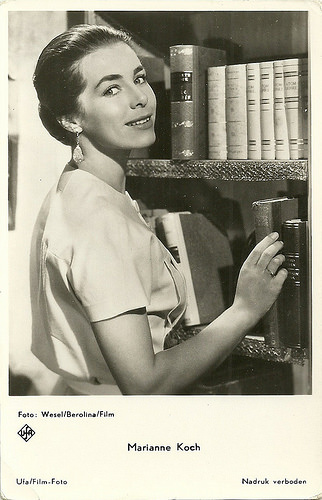
Dutch-Belgian postcard by Ufa. Photo: Wesel / Berolina Film.
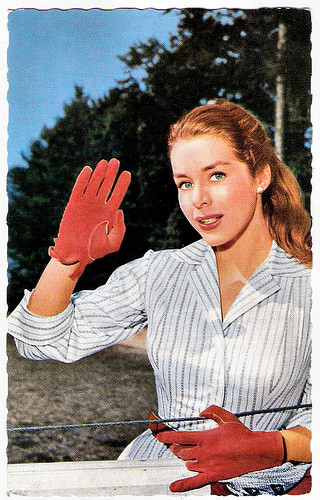
German postcard by Kolibri-Verlag, Minden/Westf., no. D 17. Photo: Constantin / Bokelberg. Publicity still for Salzburger Geschichten/Salzburg Stories (Kurt Hoffmann, 1957).
A Fistful of Dollars
In the early 1960s the decline of the German film industry increased and Marianne Koch worked more often abroad. In France she appeared in the thriller Pleins feux sur l'assassin/Spotlight on a Murderer (Georges Franju, 1961). It was based on a screenplay by Pierre Boileau and Thomas Narcejac on whose work film classics like Diabolique (Henri-Georges Clouzot, 1955) and Vertigo (Alfred Hitchcock, 1958) were based.
Another French production was the drama Napoléon II, l'aiglon/Napoleon II, the Eaglet (Claude Boissol, 1961) with Bernard Verley and Jean Marais . In the German-British-Irish spy thriller The Devil's Agent (1962, John Paddy Carstairs), she appeared opposite Peter van Eyck and Christopher Lee.
In 1963 Marianne Koch played the female lead in the popular TV mini-series Tim Frazer (Hans Quest, 1963) written by Francis Durbridge.
Then, Sergio Leone's classic Spaghetti Western Per un pugno di dollari/A Fistful of Dollars (Sergio Leone, 1964) showcased her alongside Clint Eastwood as Marisol, a woman tormented by ruthless local gangsters, torn between her husband and child and the villains.
After this career highlight followed many mediocre Edgar Wallace crime films and Spaghetti Westerns. One of the more interesting ones was the German-Israeli action film Einer spielt falsch/Trunk to Cairo (Menahem Golan, Raphael Nussbaum, 1966), which recycled Hollywood hero Audie Murphy as a James Bond-type action hero assigned to destroy a Neo-Nazi weapons factory headed by nemesis George Sanders.
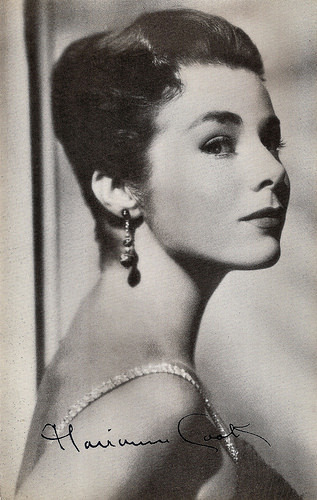
British postcard in the Celebrity Autograph Series by Celebrity Publishers Ltd., London, no. 287. Photo: Universal-International. Publicity still for Interlude (Douglas Sirk, 1957), in which she was credited as Marianne Cook.
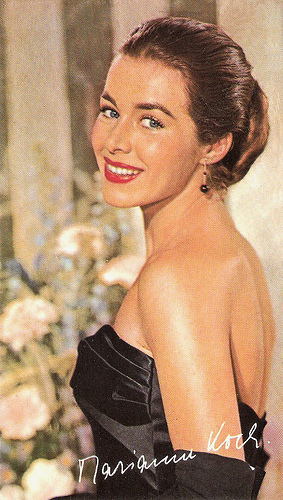
German collectors card by Luxor.
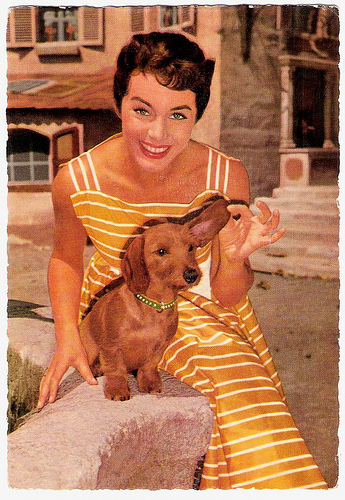
German postcard by WS-Druck, Wanne-Eickel, no. F 10. Photo: Ringpress / Vogelmann / Bavaria.
What Am I?
In Germany Marianne Koch was probably best-loved for her many years of participation in the highly popular TV game show Was bin ich? (What Am I?) which ran from the 1950s until 1988. The show achieved ratings of up to 75% at its peak.
On television she also played a journalist in the popular TV series Die Journalistin/The Journalist (1970-1971) with Bruce Low.
By then her film career was clearly over. In 1971, she resumed her medical studies which she had broken off in 1953 to become a full-time actress. She earned her doctorate in 1978 and practiced as an internist in Munich until 1997.
In the meantime, she hosted television shows and had a medical advice program on the radio. In 1976, she was one of the initial hosts of Germany's pioneering talk show 3 nach 9/Three After Nine, for which she was awarded one of the most prestigious awards of the German television industry, the Grimme Preis.
Since 1997 she is the president of the Deutschen Schmerzliga (German Pain League). She has published medical books as Mein Gesundheitsbuch (My health book) (1999) and Die Gesundheit unserer Kinder (The health of our children) (2007).
In 2002, Koch was honoured for her life's work with the Bundesverdienstkreuz (Germany‘s Cross of Merit award).
In 1953, she had married the physician Gerhard Freund, with whom she has two sons. The marriage ended in 1973 after Freund began an affair with Miss World 1956, Petra Schürmann, whom he later wed.
Marianne Koch is in a relationship with the publicist Peter Hamm since the mid 1980s. They live in Tutzing, Germany.
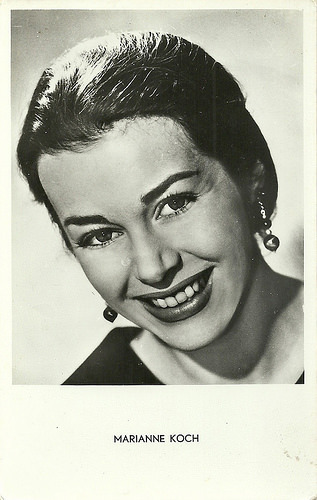
Probably Belgian postcard.
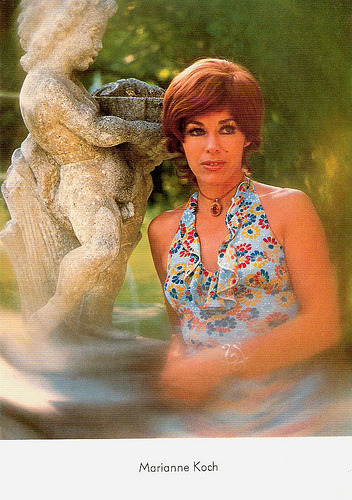
German postcard by Franz Josef Rüdel, Filmpostkartenverlag, Hamburg, no. F-72. Photo: G.M. Rozhek, München.
Marianne Koch and Heinz Rühmann sing Oh Bello in ...Vater sein dagegen sehr (1957). Source: Filmkiste (YouTube).
Sources: Stephanie d’Heil (Steffi-line - German), Wikipedia (German), and .

German postcard by ISV, no. G 1.

German postcard by Krüger, no. 902/187. Photo: Klaus Collignon.

German postcard by Universum-Film Aktiengesellschaft (Ufa), Berlin-Tempelhof, no. CK-36.
Best Supporting Actress of 1955
Marianne Koch was born in Munich, Germany, in 1931. She was the daughter of a businessman and a pianist. As a 10-year old she already played theatre and she was a guest student at the opera school.
In 1949 she started a medical studies at the university of Munich. As a student she made her film debut next to Rudolf Forster and Olga Tschechova in the drama Der Mann, der zweimal leben wollte/The Man Who Wanted to Live Twice (Viktor Tourjansky, 1950).
The following year she made a spontaneous appearance in Dr. Holl/Affairs of Dr. Holl (Rolf Hansen, 1951) with Maria Schell and Dieter Borsche , and in Mein Freund, der Dieb/My Friend, the Thief (Helmut Weiss, 1951) with Hans Söhnker and Hardy Krüger .
She broke off her studies to become an actress full-time. She played her first leading role in the melodrama Wetterleuchten am Dachstein/Storm Clouds over Dachstein (Anton Kutter, 1953). In the American cold war drama Night People (Nunnally Johnson, 1954) she played a supporting part alongside Gregory Peck.
She stayed in Germany and appeared with O. W. Fischer in Ludwig II: Glanz und Ende eines Königs/Mad Emperor: Ludwig II (Helmut Käutner, 1955). For her portrayal of Diddo Geiss in Des Teufels General/The Devil's General (Helmut Käutner, 1955), she received the Filmband in Silber (Film Strip in Silver) for the Best Supporting Actress of 1955.
As Marianne Cook she appeared in the Hollywood productions Four Girls in Town (Jack Sher, 1957) opposite George Nader , and Interlude (Douglas Sirk, 1957) with June Allyson and Rossano Brazzi .
In Germany she played in the comedy Salzburger Geschichten/Salzburg Stories (Kurt Hoffmann, 1957) based on a book by Erich Kästner, and in the war films Der Stern von Afrika/The Star of Africa (Alfred Weidenmann, 1957) with Joachim Hansen , and Der Fuchs von Paris/The Paris Fox (Paul May, 1957) with Hardy Krüger .
In the comedy Vater sein dagegen/To Be A Father On the Contrary (Kurt Meisel, 1957) she appeared as the bride of the almost 30 years older Heinz Rühmann . She also had success as a patent country doctor in Die Landärztin vom Tegernsee/The Country Doctor of Tegernsee (Paul May, 1958).
In Italy she appeared in the comedy Gli italiani sono matti/The Italians They Are Crazy (Duilio Coletti, Luis María Delgado, 1958) starring Hollywood veteran Victor McLaglen .

With Dieter Borsche . German postcard by WS-Druck, Wanne-Eickel, no. F 79. Photo: Ringpress / Vogelmann / Bavaria.

With Joachim Hansen . German postcard by Ufa/Film-Foto, Berlin-Tempelhoff, no. FK 3658. Retail price: 25 Pfg. Photo: Brünjes / Neue Emelka / Herzog Film.

Dutch-Belgian postcard by Ufa. Photo: Wesel / Berolina Film.

German postcard by Kolibri-Verlag, Minden/Westf., no. D 17. Photo: Constantin / Bokelberg. Publicity still for Salzburger Geschichten/Salzburg Stories (Kurt Hoffmann, 1957).
A Fistful of Dollars
In the early 1960s the decline of the German film industry increased and Marianne Koch worked more often abroad. In France she appeared in the thriller Pleins feux sur l'assassin/Spotlight on a Murderer (Georges Franju, 1961). It was based on a screenplay by Pierre Boileau and Thomas Narcejac on whose work film classics like Diabolique (Henri-Georges Clouzot, 1955) and Vertigo (Alfred Hitchcock, 1958) were based.
Another French production was the drama Napoléon II, l'aiglon/Napoleon II, the Eaglet (Claude Boissol, 1961) with Bernard Verley and Jean Marais . In the German-British-Irish spy thriller The Devil's Agent (1962, John Paddy Carstairs), she appeared opposite Peter van Eyck and Christopher Lee.
In 1963 Marianne Koch played the female lead in the popular TV mini-series Tim Frazer (Hans Quest, 1963) written by Francis Durbridge.
Then, Sergio Leone's classic Spaghetti Western Per un pugno di dollari/A Fistful of Dollars (Sergio Leone, 1964) showcased her alongside Clint Eastwood as Marisol, a woman tormented by ruthless local gangsters, torn between her husband and child and the villains.
After this career highlight followed many mediocre Edgar Wallace crime films and Spaghetti Westerns. One of the more interesting ones was the German-Israeli action film Einer spielt falsch/Trunk to Cairo (Menahem Golan, Raphael Nussbaum, 1966), which recycled Hollywood hero Audie Murphy as a James Bond-type action hero assigned to destroy a Neo-Nazi weapons factory headed by nemesis George Sanders.

British postcard in the Celebrity Autograph Series by Celebrity Publishers Ltd., London, no. 287. Photo: Universal-International. Publicity still for Interlude (Douglas Sirk, 1957), in which she was credited as Marianne Cook.

German collectors card by Luxor.

German postcard by WS-Druck, Wanne-Eickel, no. F 10. Photo: Ringpress / Vogelmann / Bavaria.
What Am I?
In Germany Marianne Koch was probably best-loved for her many years of participation in the highly popular TV game show Was bin ich? (What Am I?) which ran from the 1950s until 1988. The show achieved ratings of up to 75% at its peak.
On television she also played a journalist in the popular TV series Die Journalistin/The Journalist (1970-1971) with Bruce Low.
By then her film career was clearly over. In 1971, she resumed her medical studies which she had broken off in 1953 to become a full-time actress. She earned her doctorate in 1978 and practiced as an internist in Munich until 1997.
In the meantime, she hosted television shows and had a medical advice program on the radio. In 1976, she was one of the initial hosts of Germany's pioneering talk show 3 nach 9/Three After Nine, for which she was awarded one of the most prestigious awards of the German television industry, the Grimme Preis.
Since 1997 she is the president of the Deutschen Schmerzliga (German Pain League). She has published medical books as Mein Gesundheitsbuch (My health book) (1999) and Die Gesundheit unserer Kinder (The health of our children) (2007).
In 2002, Koch was honoured for her life's work with the Bundesverdienstkreuz (Germany‘s Cross of Merit award).
In 1953, she had married the physician Gerhard Freund, with whom she has two sons. The marriage ended in 1973 after Freund began an affair with Miss World 1956, Petra Schürmann, whom he later wed.
Marianne Koch is in a relationship with the publicist Peter Hamm since the mid 1980s. They live in Tutzing, Germany.

Probably Belgian postcard.

German postcard by Franz Josef Rüdel, Filmpostkartenverlag, Hamburg, no. F-72. Photo: G.M. Rozhek, München.
Marianne Koch and Heinz Rühmann sing Oh Bello in ...Vater sein dagegen sehr (1957). Source: Filmkiste (YouTube).
Sources: Stephanie d’Heil (Steffi-line - German), Wikipedia (German), and .
Published on November 20, 2014 22:00
November 19, 2014
Nathalie Delon
Beautiful French actress Nathalie Delon (1941) is a former wife of Alain Delon and the mother of Anthony Delon. Her film debut in the classic thriller Le Samouraï (1967) proved also to be the peak of her career.
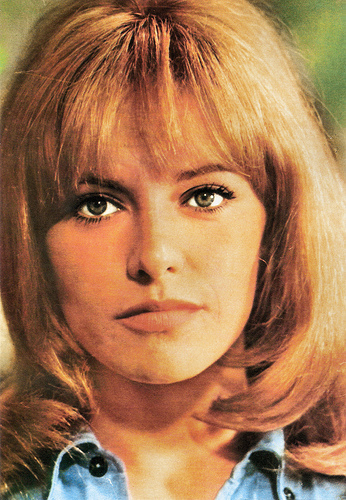
Spanish postcard by Bergas Industrias Graficas, no. 1081, 1974. Photo: Photo Vedettes ENR, Charlesbourg (Canada).
One of the most beautiful women in the world
Nathalie Delon was born as Francine Canovas in Oujda, French Morocco in 1941. She was the daughter of a French officer. Her young mother moved with her to France, first to Nice and later to Paris.
In 1959 Francine married Guy Barthelemy in French Marocco with whom she had a daughter, Nathalie. She soon returned to France and they divorced in 1963.
Francine started her career as a model and at the time, she was reputedly one of the most beautiful women in the world. In 1962 she had met Alain Delon and in 1964 they married. Their son Anthony Delon , born a month later, would become a well-known film star.
Nathalie’s own cinema career started when French filmmaker Jean-Pierre Melville asked her to play in his French-Italian crime film Le Samouraï/The Samurai (1967) in which her husband Alain Delon featured as professional hit man Jef Costello.
James Travers at French Films : “Perhaps the most highly regarded and best-known of all French gangster movies is Jean-Pierre Melville's Le Samouraï, a stylish noir thriller which gave actor Alain Delon his most iconic screen role and helped to establish the policier as one of the most important genres in French cinema for over a decade.”
Melville's insistence on casting Nathalie as Jef's prostitute mistress resulted in serious ructions between the director and his lead actor - at the time, the couple were in the process of separating and would divorce before the film was released. The film became a box office hit in France, where it attracted over two million spectators and was also a comparable success abroad.
Lucia Bozzola at AllMovie : “Originally released in the U.S. in an edited, dubbed version [as The Godson] meant to capitalize on the popularity of The Godfather (1972), Le samouraï was restored to its original form in the 1990s, although its visual flourishes, procedural flair, and Delon's existential sangfroid had long since infiltrated the international neo-noir lexicon. It directly inspired John Woo's The Killer (1989) and Jim Jarmusch's Ghost Dog: The Way of the Samurai (2000), among others.“
Two years later Nathalie Delon also had a small part in Melville’s L'armée des ombres/Army of Shadows (Jean-Pierre Melville, 1969), a film adaptation of a novel by Joseph Kessel. It follows a small group of Resistance fighters as they move between safe houses, work with the Allied militaries, kill informers, and attempt to evade the capture and execution that they know is their most likely fate.
While portraying its characters as heroic, the film presents a bleak, unromantic view of the Resistance. At the time of its initial release in France, Army of Shadows was not well received or widely seen. In the mid-1990s, Cahiers du cinéma published a reappraisal of the film and Melville's work in general, leading to its restoration and re-release in 2006.
In between the two famous Melville classics, Delon also appeared in other interesting films including the dramas La leçon particulière/Tender Moment (Michel Boisrond, 1968) with Renaud Verley, and Le sorelle/The sisters (Roberto Malenotti, 1969) starring Susan Strasberg.
At the time, Nathalie Delon was caught up in a scandal. With husband Alain Delon, she was questioned by the police over the murder of their former Yugoslav bodyguard, Stevan Markovic, with whom she also had had a brief affair. Markovic’s corpse was found in a wood, wrapped in a mattress. Investigators found a letter from Markovic linking the Delons and a Corsican fighter named François Marcantoni. The Markovic affair began to absorb France’s political elite when connections were made with former president Georges Pompidou. In the end, only Marcantoni was convicted. Nathalie and Alain Delon divorced in 1968, but she kept his name. The affair did not hurt their careers.
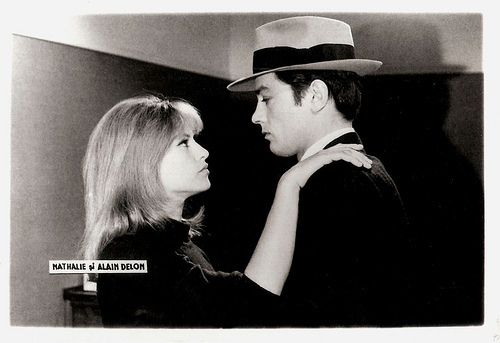
Small Romanian collectors card. Photo: publicity still for Le Samouraï (Jean-Pierre Melville, 1967).

Romanian postcard by Casa Filmului Acin.
I've Seen That Face Before
Nathalie Delon made her English language debut opposite Anthony Hopkins in the espionage thriller When Eight Bells Toll (Etienne Perier, 1971), set in Scotland and scripted by Alistair MacLean based on his own novel. Producer Elliott Kastner hoped that the film would be the first of a series of spy adventures films featuring MacLean's Philip Calvert character by capturing James Bond series fans after the anticipated demise of that series ( Sean Connery was said to quit the Bond series).
When Eight Bells Tolls attracted limited viewers, although it was the 11th most popular film at the British box office in 1971 and Connery returned as Bond n the successful Diamonds Are Forever (Guy Hamilton, 1971). So the projected Phillip Calvert series was cancelled.
Delon then was one of Bluebeard’s wives in the thriller Bluebeard (Edward Dmytryk, 1972) featuring Richard Burton as a wealthy Austrian Baron and World War I pilot, who murders his wives. During the shooting, she dated Richard Burton then the husband of Elizabeth Taylor. She also had dated Eddie Fisher, Taylor’s former husband.
Delon had a supporting part in the British film The Romantic Englishwoman (Joseph Losey, 1975), starring Michael Caine, Glenda Jackson and Helmut Berger . Also noteworthy is her lead in Peter Whitehead’s final film Fire in the Water (1977) with David Hockney and John Lennon . But her other European films of the 1970s are mediocre.
On TV she did a guest star appearance in an episode of the series Madame le juge/Madame, the judge (Édouard Molinaro, 1978) featuring Simone Signoret .
In 1982, she co-directed and starred in the drama Ils appellent ça un accident/They Call It an Accident (Nathalie Delon, Yves Deschamps, 1982), but it was not a success. The following year, she appeared in the short film Pair-impair (Carole Marquand, 1983). She directed one more film, the French-American romantic comedy Sweet Lies (1988), starring Treat Williams, Joanna Pacula and Julianne Phillips. Again it was not a success. She then retired.
About her later personal life is known that she had a relationship with actor Marc Porel and both suffered a drug addiction. She conquered the habit and went to the US.
There she lived with Chris Blackwell, founder of the Island label and manager of Bob Marley. Delon wrote the French text for Grace Jones megahit I've Seen That Face Before (Libertango) (1981), which features on the soundtrack of Frantic (Roman Polanski, 1988).
In 2006, she published the book Pleure pas, c'est pas grave (Do not cry, it does not matter), and twenty years after directing Sweet Lies, she returned to the cinema in the drama Nuit de chien/This Night (Werner Schroeter, 2008) about a group of people try to flee from a dictatorship government.
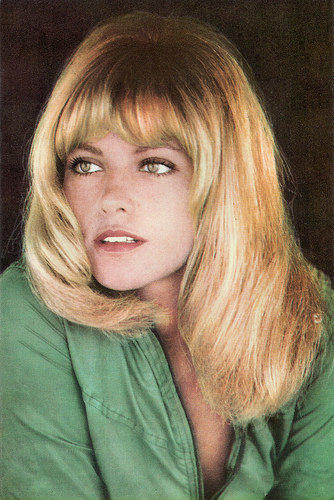
Romanian postcard by Casa Filmului Acin, no 112.
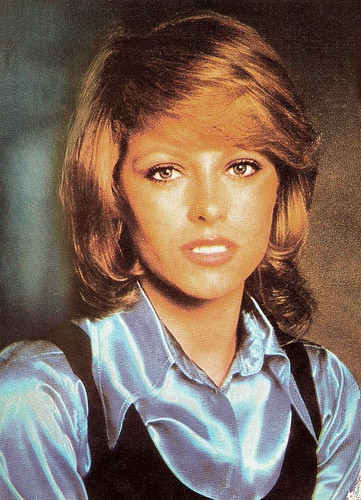
Romanian postcard by Casa Filmului Acin, no. 431.
Sources: James Travers (Films de France), Lucia Bozzola (AllMovie), Luc Le Vaillant (Liberation – French), Celine Colassin (D’autres étoiles filantes - French), Connexxion France, Prisma.de (German), Wikipedia (English) and .

Spanish postcard by Bergas Industrias Graficas, no. 1081, 1974. Photo: Photo Vedettes ENR, Charlesbourg (Canada).
One of the most beautiful women in the world
Nathalie Delon was born as Francine Canovas in Oujda, French Morocco in 1941. She was the daughter of a French officer. Her young mother moved with her to France, first to Nice and later to Paris.
In 1959 Francine married Guy Barthelemy in French Marocco with whom she had a daughter, Nathalie. She soon returned to France and they divorced in 1963.
Francine started her career as a model and at the time, she was reputedly one of the most beautiful women in the world. In 1962 she had met Alain Delon and in 1964 they married. Their son Anthony Delon , born a month later, would become a well-known film star.
Nathalie’s own cinema career started when French filmmaker Jean-Pierre Melville asked her to play in his French-Italian crime film Le Samouraï/The Samurai (1967) in which her husband Alain Delon featured as professional hit man Jef Costello.
James Travers at French Films : “Perhaps the most highly regarded and best-known of all French gangster movies is Jean-Pierre Melville's Le Samouraï, a stylish noir thriller which gave actor Alain Delon his most iconic screen role and helped to establish the policier as one of the most important genres in French cinema for over a decade.”
Melville's insistence on casting Nathalie as Jef's prostitute mistress resulted in serious ructions between the director and his lead actor - at the time, the couple were in the process of separating and would divorce before the film was released. The film became a box office hit in France, where it attracted over two million spectators and was also a comparable success abroad.
Lucia Bozzola at AllMovie : “Originally released in the U.S. in an edited, dubbed version [as The Godson] meant to capitalize on the popularity of The Godfather (1972), Le samouraï was restored to its original form in the 1990s, although its visual flourishes, procedural flair, and Delon's existential sangfroid had long since infiltrated the international neo-noir lexicon. It directly inspired John Woo's The Killer (1989) and Jim Jarmusch's Ghost Dog: The Way of the Samurai (2000), among others.“
Two years later Nathalie Delon also had a small part in Melville’s L'armée des ombres/Army of Shadows (Jean-Pierre Melville, 1969), a film adaptation of a novel by Joseph Kessel. It follows a small group of Resistance fighters as they move between safe houses, work with the Allied militaries, kill informers, and attempt to evade the capture and execution that they know is their most likely fate.
While portraying its characters as heroic, the film presents a bleak, unromantic view of the Resistance. At the time of its initial release in France, Army of Shadows was not well received or widely seen. In the mid-1990s, Cahiers du cinéma published a reappraisal of the film and Melville's work in general, leading to its restoration and re-release in 2006.
In between the two famous Melville classics, Delon also appeared in other interesting films including the dramas La leçon particulière/Tender Moment (Michel Boisrond, 1968) with Renaud Verley, and Le sorelle/The sisters (Roberto Malenotti, 1969) starring Susan Strasberg.
At the time, Nathalie Delon was caught up in a scandal. With husband Alain Delon, she was questioned by the police over the murder of their former Yugoslav bodyguard, Stevan Markovic, with whom she also had had a brief affair. Markovic’s corpse was found in a wood, wrapped in a mattress. Investigators found a letter from Markovic linking the Delons and a Corsican fighter named François Marcantoni. The Markovic affair began to absorb France’s political elite when connections were made with former president Georges Pompidou. In the end, only Marcantoni was convicted. Nathalie and Alain Delon divorced in 1968, but she kept his name. The affair did not hurt their careers.

Small Romanian collectors card. Photo: publicity still for Le Samouraï (Jean-Pierre Melville, 1967).

Romanian postcard by Casa Filmului Acin.
I've Seen That Face Before
Nathalie Delon made her English language debut opposite Anthony Hopkins in the espionage thriller When Eight Bells Toll (Etienne Perier, 1971), set in Scotland and scripted by Alistair MacLean based on his own novel. Producer Elliott Kastner hoped that the film would be the first of a series of spy adventures films featuring MacLean's Philip Calvert character by capturing James Bond series fans after the anticipated demise of that series ( Sean Connery was said to quit the Bond series).
When Eight Bells Tolls attracted limited viewers, although it was the 11th most popular film at the British box office in 1971 and Connery returned as Bond n the successful Diamonds Are Forever (Guy Hamilton, 1971). So the projected Phillip Calvert series was cancelled.
Delon then was one of Bluebeard’s wives in the thriller Bluebeard (Edward Dmytryk, 1972) featuring Richard Burton as a wealthy Austrian Baron and World War I pilot, who murders his wives. During the shooting, she dated Richard Burton then the husband of Elizabeth Taylor. She also had dated Eddie Fisher, Taylor’s former husband.
Delon had a supporting part in the British film The Romantic Englishwoman (Joseph Losey, 1975), starring Michael Caine, Glenda Jackson and Helmut Berger . Also noteworthy is her lead in Peter Whitehead’s final film Fire in the Water (1977) with David Hockney and John Lennon . But her other European films of the 1970s are mediocre.
On TV she did a guest star appearance in an episode of the series Madame le juge/Madame, the judge (Édouard Molinaro, 1978) featuring Simone Signoret .
In 1982, she co-directed and starred in the drama Ils appellent ça un accident/They Call It an Accident (Nathalie Delon, Yves Deschamps, 1982), but it was not a success. The following year, she appeared in the short film Pair-impair (Carole Marquand, 1983). She directed one more film, the French-American romantic comedy Sweet Lies (1988), starring Treat Williams, Joanna Pacula and Julianne Phillips. Again it was not a success. She then retired.
About her later personal life is known that she had a relationship with actor Marc Porel and both suffered a drug addiction. She conquered the habit and went to the US.
There she lived with Chris Blackwell, founder of the Island label and manager of Bob Marley. Delon wrote the French text for Grace Jones megahit I've Seen That Face Before (Libertango) (1981), which features on the soundtrack of Frantic (Roman Polanski, 1988).
In 2006, she published the book Pleure pas, c'est pas grave (Do not cry, it does not matter), and twenty years after directing Sweet Lies, she returned to the cinema in the drama Nuit de chien/This Night (Werner Schroeter, 2008) about a group of people try to flee from a dictatorship government.

Romanian postcard by Casa Filmului Acin, no 112.

Romanian postcard by Casa Filmului Acin, no. 431.
Sources: James Travers (Films de France), Lucia Bozzola (AllMovie), Luc Le Vaillant (Liberation – French), Celine Colassin (D’autres étoiles filantes - French), Connexxion France, Prisma.de (German), Wikipedia (English) and .
Published on November 19, 2014 23:00
November 18, 2014
Nicolas Rimsky
Russian actor Nicolas Rimsky (1886-1941) is most famous for his silent films of the 1920s produced in France. Rimsky also performed in several Russian films in the late 1910s and he also had parts in the French sound cinema of the 1930s.
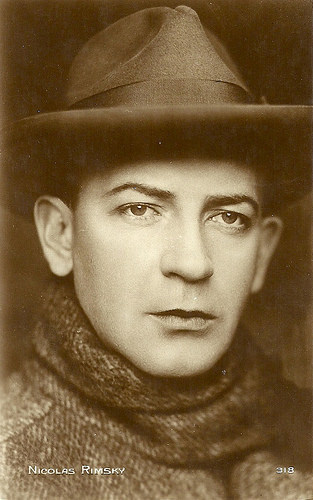
French postcard by Editions Cinémagazine, no. 318.
Protazanov
Nicolas Rimsky was born in Moscow in 1886.
He started out in Russian cinema in 1916, not only as actor but also as scriptwriter. His first film acting role was in Yastrebinoe gnedzo/The Cloven Tongue (Cheslav Sabinsky, 1916).
This debut was followed by Ledyanoy dom/The House of Ice (Konstantin Eggert, 1916), while he wrote the script for Yakov Protazanov's Zhenschina s kinzhalom/The Woman with the Dagger (Yakov Protazanov, 1916) with Ivan Mozzhukhin .
The next year he played in three films by Protazanov: Otyets Sergei/Father Sergius (Yakov Protazanov, Alexandre Volkoff, 1917), Proktalie millioni/Damned Millions (Yakov Protazanov, 1917), and Andrei Kozhukov (Yakov Protazanov, 1917), again with Ivan Mozzhukhin .
In 1918 he appeared in Khamka (Aleksandr Ivanovsky, 1918), Dnevnik Nelli/The Diary of Nellie (Aleksandr Ivanovsky, 1918), Kaliostro/Cagliostro (Wladyslaw Starewicz, 1918), and Taine korolevy/The Secret of a Queen (Yakov Protazanov, 1918) with Nathalie Lissenko .
His last film in Russia was Protazanov's To nadezhda, to revnost spelaya/Jealousy is Blind (Yakov Protazanov, 1919).
With the troupe of Ermoliev, including Ivan Mozzhukhin , Nathalie Lissenko , Nicolas Koline and Yakov Protazanov, Rimsky first moved to Crimea and then to France, where he would have an excellent career during the 1920s.
At Ermoliev's studio in Montreuil, he played roles in L'écheance fatale/The fatal Term (Alexandre Volkov, 1921) and La tourmente/The Storm (Serge Nadejdine, 1921).
1921 was mainly dedicated to the 12-episode serial La fille sauvage/The Wild Girl (Henri Etievant, 1921), opposite Romuald Joubé and Nathalie Lissenko .
Then followed three films by Viktor Tourjansky: Nuit de carnaval/Carnival Night (1922) with Nicolas Koline , Calvaire d'amour/Love Ordeal (1923) with Nathalie Lissenko and Charles Vanel , and the successful comedy Ce cochon de Morin/This Pig of Morin (1923).
For these films Rimsky also wrote the script and the adaptation of the stage play. Also for the next two films in which he acted, Rimsky did the adaptation and scenario as well: L'heureuse mort/Happy Death (Serge Nadejdine, 1924) and La cible/The Target (Serge Nadejdine, 1924).
After his role in La dame masquée/The Masked Lady (Viktor Tourjansky, 1924), Rimsky was ready to become a film director as well. While his roles had been quite diversified in the early 1920s, he would specialize in comedy henceforth because of the success of the comedy Ce cochon de Morin.
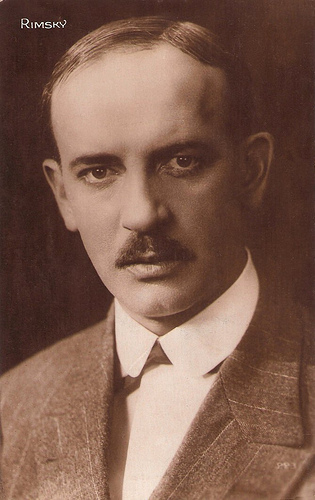
French postcard by Cinémagazine Editions, no. 223.
Double Life
Nicolas Rimsky's first direction was the funny comedy Paris en cinq jours/Paris in Five Days (1925), co-directed with Pierre Colombier. Dolly Davis and Rimsky himself played the leading roles, and again he did the adaptation and the script as well.
His next direction, together with Serge Nadejdine and Henry Wulschleger was La nègre blanc/The White Negro (1925), for which he also did adaptation and scenario.
His third and fourth direction were the romantic comedy Jim la Houlette, roi des voleurs/Jim the Cracksman, the King of Thieves (co-directed with Roger Lion, 1926) and Le chasseur de chez Maxim's/Maxim's Porter (1927). In Jim la Houlette, Rimsky is a timid secretary who pretends to be a notorious thief, just to impress the daughter of his employer, a thriller writer. Of course things go wrong.
In Le chasseur de chez Maxim's Rimsky again leads a double life, this time of an ordinary man with a second life in the night time. The story was co-written by Max Linder .
After that, Rimsky returned to acting. He appeared in the French films Minuit... Place Pigalle/Midnight at Place Pigalle (René Hervil, 1928), a rare tragic film, and Parce que je t'aime/Because I Love You (Hewitt Claypoole Grantham-Hayes, 1928).
He also made two German films: Unmoral/Immorality (Willi Wolf, 1928) with Ellen Richter , and the horror film Cagliostro/ (Richard Oswald, 1928) starring Hans Stüwe.
After his last silent role in Trois jeunes filles nues/Three Naked Flappers (Robert Boudrioz, 1929) starring Annabella , Rimsky co-directed with Nicolas Evreinoff his first sound film: the comedy Pas sur la bouche/Not On the Lips (1930). It was also his last film direction.
Until 1939 he would continue to play supporting parts in French films. These films include La voit qui meurt/The Dying Voice (Gennaro Dini, 1932), Nostalgie/The Postmaster's Daughter (Viktor Tourjansky, 1937) starring Harry Baur , Le patriote/The Patriot (Maurice Tourneur, 1938) with Harry Baur and Suzy Prim , and Menaces/Threats (Edmond T. Gréville, 1939) starring Mireille Balin .
Nicolas Rimsky died in 1941 in Marseille, France.
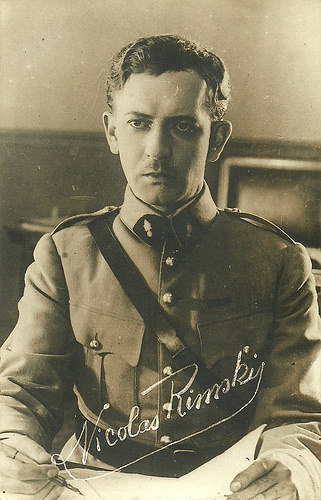
French postcard. Nicolas Rimsky probably in the Albatros producton Calvaire d'amour (Viktor Tourjansky, 1923).
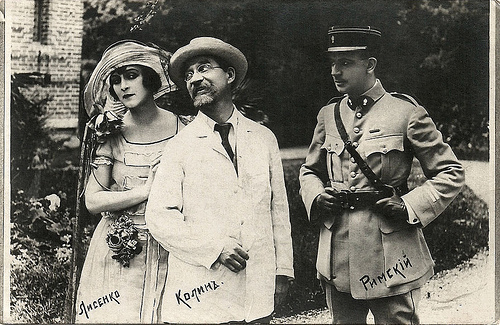
French postcard, with names written in Russian. The Russian actors Nathalie Lissenko , Nicolas Koline and Nicolas Koline in the Albatros producton Calvaire d'amour (Viktor Tourjansky, 1923).
Sources: François Albéra (Albatros. Des Russes à Paris, 1919-1929 - French), CineArtistes (French) and .

French postcard by Editions Cinémagazine, no. 318.
Protazanov
Nicolas Rimsky was born in Moscow in 1886.
He started out in Russian cinema in 1916, not only as actor but also as scriptwriter. His first film acting role was in Yastrebinoe gnedzo/The Cloven Tongue (Cheslav Sabinsky, 1916).
This debut was followed by Ledyanoy dom/The House of Ice (Konstantin Eggert, 1916), while he wrote the script for Yakov Protazanov's Zhenschina s kinzhalom/The Woman with the Dagger (Yakov Protazanov, 1916) with Ivan Mozzhukhin .
The next year he played in three films by Protazanov: Otyets Sergei/Father Sergius (Yakov Protazanov, Alexandre Volkoff, 1917), Proktalie millioni/Damned Millions (Yakov Protazanov, 1917), and Andrei Kozhukov (Yakov Protazanov, 1917), again with Ivan Mozzhukhin .
In 1918 he appeared in Khamka (Aleksandr Ivanovsky, 1918), Dnevnik Nelli/The Diary of Nellie (Aleksandr Ivanovsky, 1918), Kaliostro/Cagliostro (Wladyslaw Starewicz, 1918), and Taine korolevy/The Secret of a Queen (Yakov Protazanov, 1918) with Nathalie Lissenko .
His last film in Russia was Protazanov's To nadezhda, to revnost spelaya/Jealousy is Blind (Yakov Protazanov, 1919).
With the troupe of Ermoliev, including Ivan Mozzhukhin , Nathalie Lissenko , Nicolas Koline and Yakov Protazanov, Rimsky first moved to Crimea and then to France, where he would have an excellent career during the 1920s.
At Ermoliev's studio in Montreuil, he played roles in L'écheance fatale/The fatal Term (Alexandre Volkov, 1921) and La tourmente/The Storm (Serge Nadejdine, 1921).
1921 was mainly dedicated to the 12-episode serial La fille sauvage/The Wild Girl (Henri Etievant, 1921), opposite Romuald Joubé and Nathalie Lissenko .
Then followed three films by Viktor Tourjansky: Nuit de carnaval/Carnival Night (1922) with Nicolas Koline , Calvaire d'amour/Love Ordeal (1923) with Nathalie Lissenko and Charles Vanel , and the successful comedy Ce cochon de Morin/This Pig of Morin (1923).
For these films Rimsky also wrote the script and the adaptation of the stage play. Also for the next two films in which he acted, Rimsky did the adaptation and scenario as well: L'heureuse mort/Happy Death (Serge Nadejdine, 1924) and La cible/The Target (Serge Nadejdine, 1924).
After his role in La dame masquée/The Masked Lady (Viktor Tourjansky, 1924), Rimsky was ready to become a film director as well. While his roles had been quite diversified in the early 1920s, he would specialize in comedy henceforth because of the success of the comedy Ce cochon de Morin.

French postcard by Cinémagazine Editions, no. 223.
Double Life
Nicolas Rimsky's first direction was the funny comedy Paris en cinq jours/Paris in Five Days (1925), co-directed with Pierre Colombier. Dolly Davis and Rimsky himself played the leading roles, and again he did the adaptation and the script as well.
His next direction, together with Serge Nadejdine and Henry Wulschleger was La nègre blanc/The White Negro (1925), for which he also did adaptation and scenario.
His third and fourth direction were the romantic comedy Jim la Houlette, roi des voleurs/Jim the Cracksman, the King of Thieves (co-directed with Roger Lion, 1926) and Le chasseur de chez Maxim's/Maxim's Porter (1927). In Jim la Houlette, Rimsky is a timid secretary who pretends to be a notorious thief, just to impress the daughter of his employer, a thriller writer. Of course things go wrong.
In Le chasseur de chez Maxim's Rimsky again leads a double life, this time of an ordinary man with a second life in the night time. The story was co-written by Max Linder .
After that, Rimsky returned to acting. He appeared in the French films Minuit... Place Pigalle/Midnight at Place Pigalle (René Hervil, 1928), a rare tragic film, and Parce que je t'aime/Because I Love You (Hewitt Claypoole Grantham-Hayes, 1928).
He also made two German films: Unmoral/Immorality (Willi Wolf, 1928) with Ellen Richter , and the horror film Cagliostro/ (Richard Oswald, 1928) starring Hans Stüwe.
After his last silent role in Trois jeunes filles nues/Three Naked Flappers (Robert Boudrioz, 1929) starring Annabella , Rimsky co-directed with Nicolas Evreinoff his first sound film: the comedy Pas sur la bouche/Not On the Lips (1930). It was also his last film direction.
Until 1939 he would continue to play supporting parts in French films. These films include La voit qui meurt/The Dying Voice (Gennaro Dini, 1932), Nostalgie/The Postmaster's Daughter (Viktor Tourjansky, 1937) starring Harry Baur , Le patriote/The Patriot (Maurice Tourneur, 1938) with Harry Baur and Suzy Prim , and Menaces/Threats (Edmond T. Gréville, 1939) starring Mireille Balin .
Nicolas Rimsky died in 1941 in Marseille, France.

French postcard. Nicolas Rimsky probably in the Albatros producton Calvaire d'amour (Viktor Tourjansky, 1923).

French postcard, with names written in Russian. The Russian actors Nathalie Lissenko , Nicolas Koline and Nicolas Koline in the Albatros producton Calvaire d'amour (Viktor Tourjansky, 1923).
Sources: François Albéra (Albatros. Des Russes à Paris, 1919-1929 - French), CineArtistes (French) and .
Published on November 18, 2014 23:00
November 17, 2014
Inge Egger
Austrian actress Inge Egger (1923–1976) starred as the simple, modest and charming girl in dozens of West-German entertainment films of the 1950s. She is best known as the singer of the all-girl band in the comedy Fanfaren der Liebe/Fanfares of Love (Kurt Hoffmann, 1951), which became the basis for Some Like It Hot (Billy Wilder, 1959). Only a few years later, illness, personal problems and negative media coverage caused Egger to retire from show business.
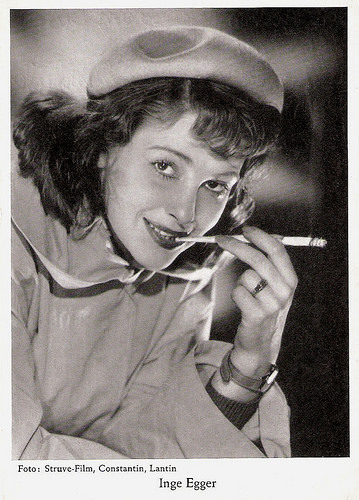
German collectors card. Photo: Struve-Film / Constantin / Lantin.
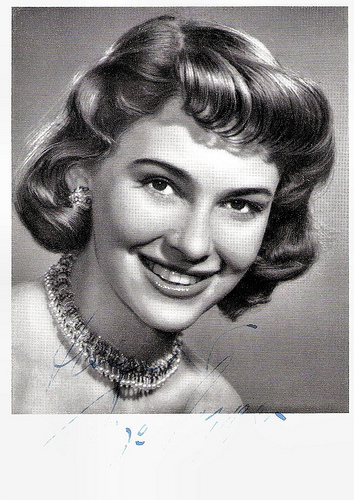
German autograph card.
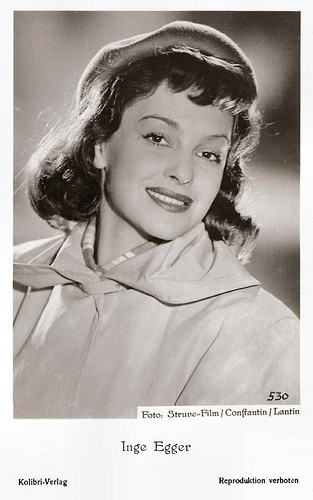
German postcard by Kolibri-Verlag, no. 530. Photo: Struwe-Film / Constantin / Lantin.
The Alpine Violets
Ingeborg Gertrud Josefine Egger was born in Linz, Austria, in 1923, as the daughter of a merchant. She studied acting at the Max-Reinhardt-Seminar in Vienna.
Her film debut was in the German-Austrian production Schrammeln (Géza von Bolváry, 1944). The film about a 19th century Vienna folk music quartet starred Marte Harell , Hans Holt , Paul Hörbiger and Hans Moser .
After that she signed a contract for six years with the Theater in der Josefstadt, where she acted in plays by Marcel Pagnol, and Friedrich Schiller. In 1949, she went on an extensive tour through Germany with Paula Wessely in the drama The Lady from the Sea by Henrik Ibsen.
A glandular disease caused her to be thick, so she could not work on screen for some years.
Her breakthrough in the cinema came with her leading role in the box office hit Fanfaren der Liebe/Fanfares of Love (Kurt Hoffmann, 1951). In this comedy Dieter Borsche and Georg Thomalla co-starred as two desperate out-of-work musicians who join in drag the Alpine Violets, an all-girl orchestra. The lovely and fresh Egger is the singer of the band.
Timothy Damon at IMDb : “Billy Wilder may have said that he only used the premise of this film and one scene in Some like it hot, but aside from the absence of gangsters in the original and women who seem to catch on a lot quicker to what's going on, I didn't see many dissimilarities.”
Next, Egger and Dieter Borsche also co-starred in Sündige Grenze/Illegal Border (Robert A. Stemmle, 1951), a socio-critical drama about smugglers.
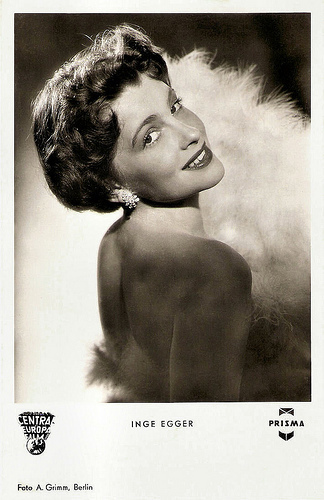
German postcard by Kunst und Bild, Berlin, no. A 804. Photo: Central-Europa / Prisma / A. Grimm. Publicity still for Die Rose von Stambul/The Rose of Stambul (Karl Anton, 1953).
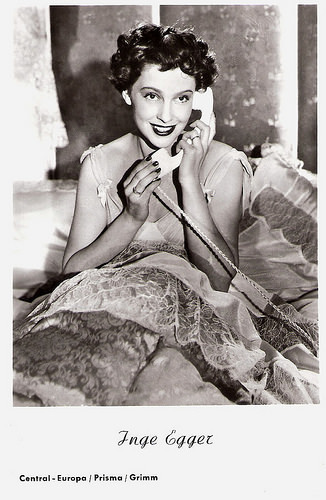
German postcard by Schneider Junior, Neunkirchen/Saar, no. 12. Photo: Central-Europa / Prisma / Grimm. Publicity still for Die Rose von Stambul/The Rose of Stambul (Karl Anton, 1953).
Illness, personal problems and a negative media coverage
In the following years, Inge Egger played leads in more than 20 films, including the musical Die Rose von Stambul/The Rose of Stamboul (Karl Anton, 1953) with Albert Lieven, the sequel Fanfaren der Ehe/Fanfares of marriage (Hans Grimm, 1953) again opposite Dieter Borsche and Georg Thomalla, and the drama Die Toteninsel/Isle of the Dead (Viktor Tourjansky, 1955) opposite Willy Birgel .
In the comedy Der Mustergatte/The Model Husband (Erik Ode, 1956), she appeared opposite Harald Juhnke and Theo Lingen . It was a remake of Der Mustergatte/The Model Husband (Wolfgang Liebeneiner, 1937) with Heinz Rühmann , which was itself based on the American play Fair and Warmer by Avery Hopwood.
Egger also starred in musical comedies like Ein Mann muß nicht immer schön sein/A Man Doesn't Always Need to Be Handsome (Hans Quest, 1956) with Peter Alexander and Der Fremdenführer von Lissabon/The guide of Lisbon (Hans Deppe, 1956) starring Vico Torriani .
However, illness, personal problems and a negative media coverage caused her to retire from the film business. Egger went to Berlin in 1956 and there she appeared in stage roles.
In the cinema, she later played only a few supporting parts, such as in the comedy-drama Das kunstseidene Mädchen/The High Life (Julien Duvivier, 1960) featuring Giulietta Masina , and the satire Wir Kellerkinder/We Cellar Children (Hans-Joachim Wiedermann, 1960) starring Wolfgang Neuss and Karin Baal .
From 1960 to 1973 she worked as a medical technician at the Berliner Bundesgesundheitsamt (the Berlin Federal Health Office). Soon the public forgot her.
In 1976, Inge Egger died of cancer in Berlin. She was only 53.
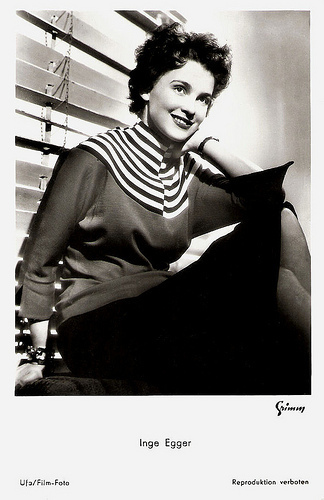
German postcard by Ufa, Berlin-Tempelhof, no. FK 872. Photo: Grimm.
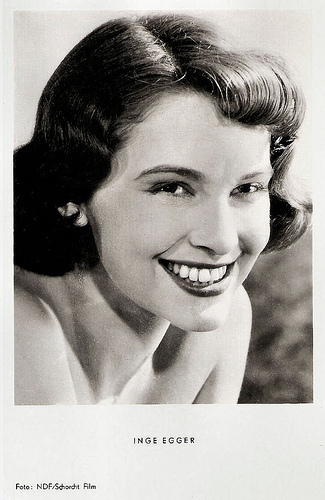
German postcard by Kunst und Bild, Berlin, no. H 477. Photo: NDF / Schorcht Film.
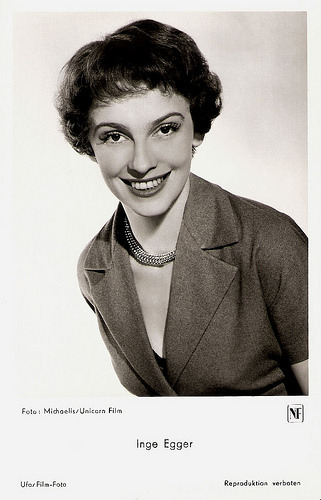
German postcard by Ufa, Berlin-Tempelhof, no. FK 2088. Photo: Michaelis / Unicorn Film / NF.
Sources: Stephanie D’heil (Steffi-line – German), Rudi Polt (Find A Grave), Wikipedia (German and English), and .

German collectors card. Photo: Struve-Film / Constantin / Lantin.

German autograph card.

German postcard by Kolibri-Verlag, no. 530. Photo: Struwe-Film / Constantin / Lantin.
The Alpine Violets
Ingeborg Gertrud Josefine Egger was born in Linz, Austria, in 1923, as the daughter of a merchant. She studied acting at the Max-Reinhardt-Seminar in Vienna.
Her film debut was in the German-Austrian production Schrammeln (Géza von Bolváry, 1944). The film about a 19th century Vienna folk music quartet starred Marte Harell , Hans Holt , Paul Hörbiger and Hans Moser .
After that she signed a contract for six years with the Theater in der Josefstadt, where she acted in plays by Marcel Pagnol, and Friedrich Schiller. In 1949, she went on an extensive tour through Germany with Paula Wessely in the drama The Lady from the Sea by Henrik Ibsen.
A glandular disease caused her to be thick, so she could not work on screen for some years.
Her breakthrough in the cinema came with her leading role in the box office hit Fanfaren der Liebe/Fanfares of Love (Kurt Hoffmann, 1951). In this comedy Dieter Borsche and Georg Thomalla co-starred as two desperate out-of-work musicians who join in drag the Alpine Violets, an all-girl orchestra. The lovely and fresh Egger is the singer of the band.
Timothy Damon at IMDb : “Billy Wilder may have said that he only used the premise of this film and one scene in Some like it hot, but aside from the absence of gangsters in the original and women who seem to catch on a lot quicker to what's going on, I didn't see many dissimilarities.”
Next, Egger and Dieter Borsche also co-starred in Sündige Grenze/Illegal Border (Robert A. Stemmle, 1951), a socio-critical drama about smugglers.

German postcard by Kunst und Bild, Berlin, no. A 804. Photo: Central-Europa / Prisma / A. Grimm. Publicity still for Die Rose von Stambul/The Rose of Stambul (Karl Anton, 1953).

German postcard by Schneider Junior, Neunkirchen/Saar, no. 12. Photo: Central-Europa / Prisma / Grimm. Publicity still for Die Rose von Stambul/The Rose of Stambul (Karl Anton, 1953).
Illness, personal problems and a negative media coverage
In the following years, Inge Egger played leads in more than 20 films, including the musical Die Rose von Stambul/The Rose of Stamboul (Karl Anton, 1953) with Albert Lieven, the sequel Fanfaren der Ehe/Fanfares of marriage (Hans Grimm, 1953) again opposite Dieter Borsche and Georg Thomalla, and the drama Die Toteninsel/Isle of the Dead (Viktor Tourjansky, 1955) opposite Willy Birgel .
In the comedy Der Mustergatte/The Model Husband (Erik Ode, 1956), she appeared opposite Harald Juhnke and Theo Lingen . It was a remake of Der Mustergatte/The Model Husband (Wolfgang Liebeneiner, 1937) with Heinz Rühmann , which was itself based on the American play Fair and Warmer by Avery Hopwood.
Egger also starred in musical comedies like Ein Mann muß nicht immer schön sein/A Man Doesn't Always Need to Be Handsome (Hans Quest, 1956) with Peter Alexander and Der Fremdenführer von Lissabon/The guide of Lisbon (Hans Deppe, 1956) starring Vico Torriani .
However, illness, personal problems and a negative media coverage caused her to retire from the film business. Egger went to Berlin in 1956 and there she appeared in stage roles.
In the cinema, she later played only a few supporting parts, such as in the comedy-drama Das kunstseidene Mädchen/The High Life (Julien Duvivier, 1960) featuring Giulietta Masina , and the satire Wir Kellerkinder/We Cellar Children (Hans-Joachim Wiedermann, 1960) starring Wolfgang Neuss and Karin Baal .
From 1960 to 1973 she worked as a medical technician at the Berliner Bundesgesundheitsamt (the Berlin Federal Health Office). Soon the public forgot her.
In 1976, Inge Egger died of cancer in Berlin. She was only 53.

German postcard by Ufa, Berlin-Tempelhof, no. FK 872. Photo: Grimm.

German postcard by Kunst und Bild, Berlin, no. H 477. Photo: NDF / Schorcht Film.

German postcard by Ufa, Berlin-Tempelhof, no. FK 2088. Photo: Michaelis / Unicorn Film / NF.
Sources: Stephanie D’heil (Steffi-line – German), Rudi Polt (Find A Grave), Wikipedia (German and English), and .
Published on November 17, 2014 22:00
Paul van Yperen's Blog
- Paul van Yperen's profile
- 13 followers
Paul van Yperen isn't a Goodreads Author
(yet),
but they
do have a blog,
so here are some recent posts imported from
their feed.



